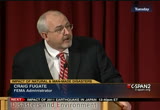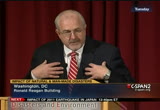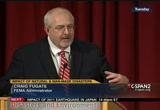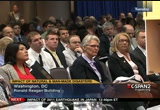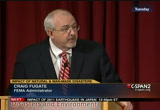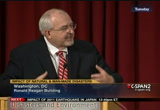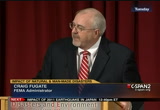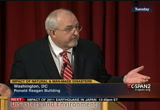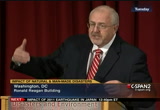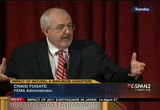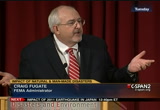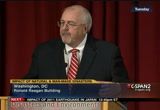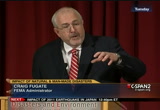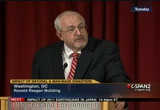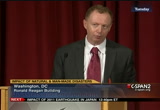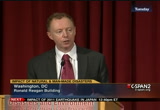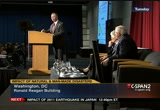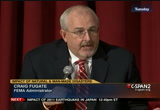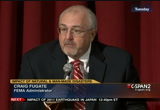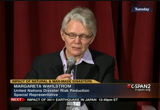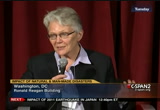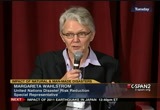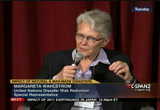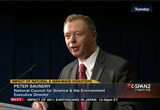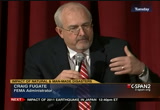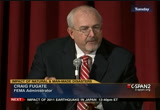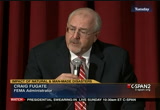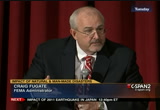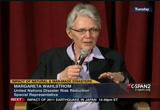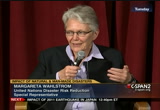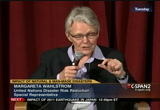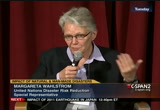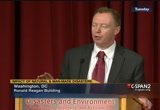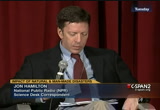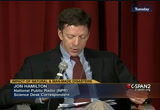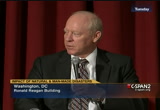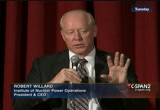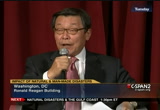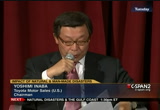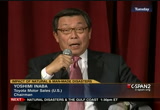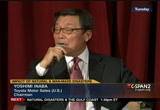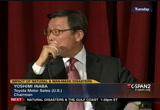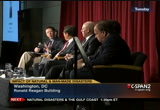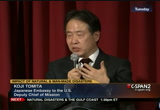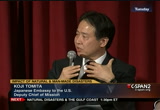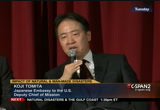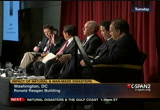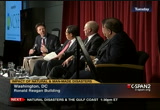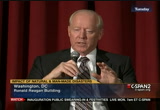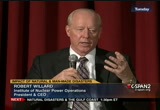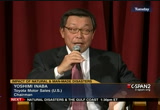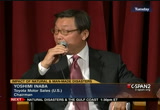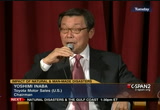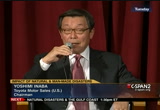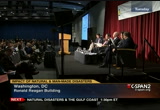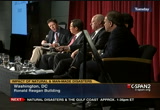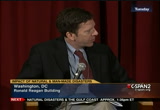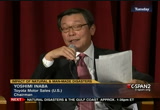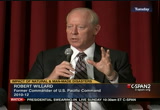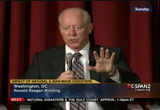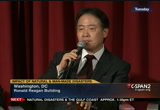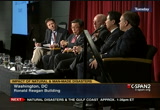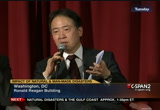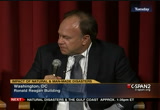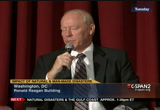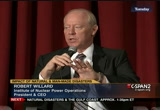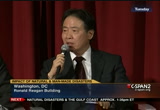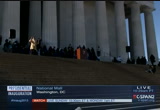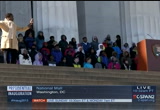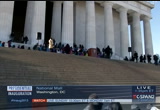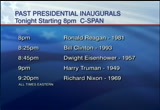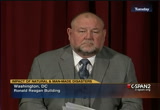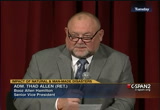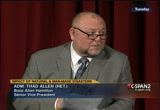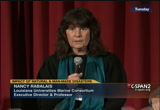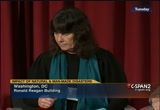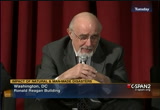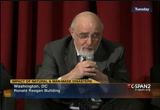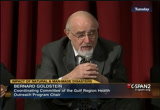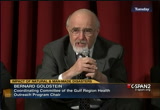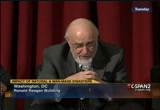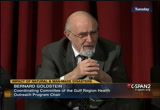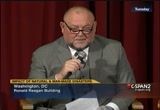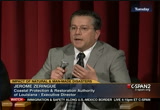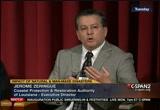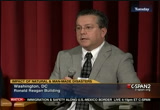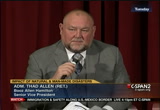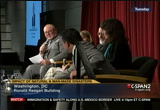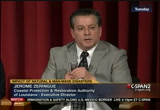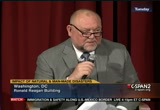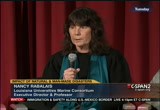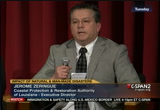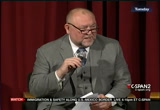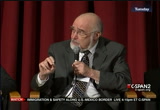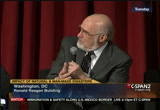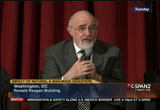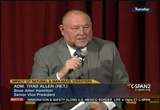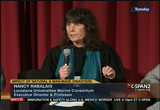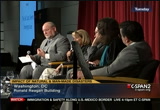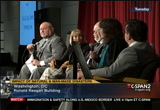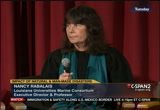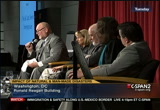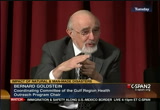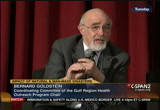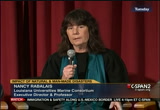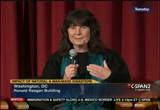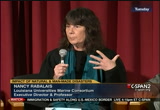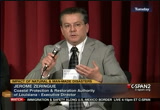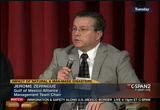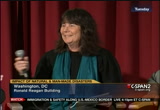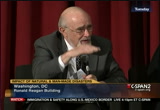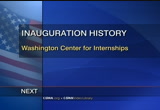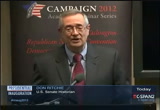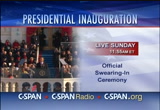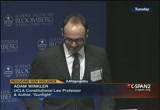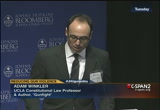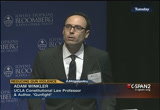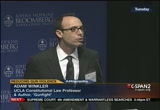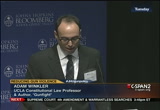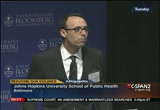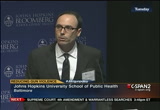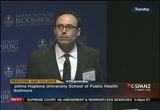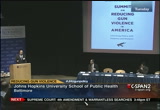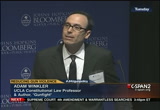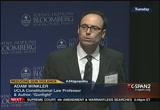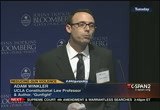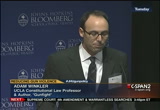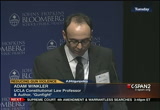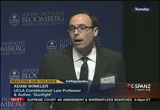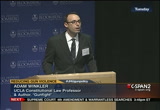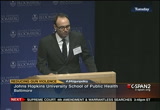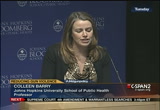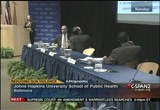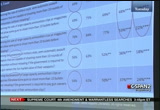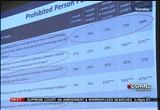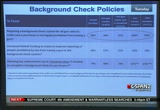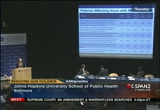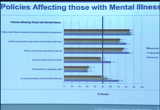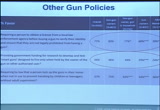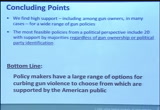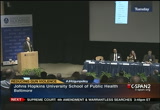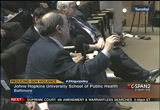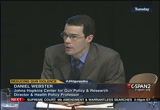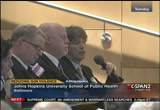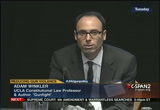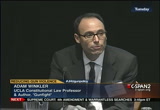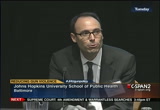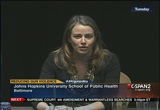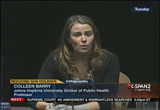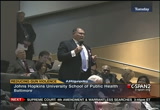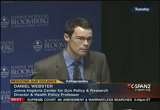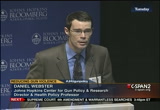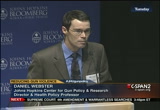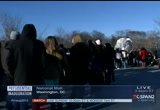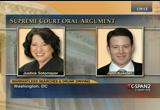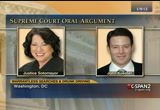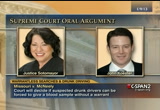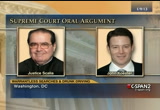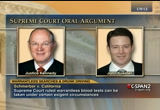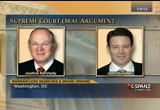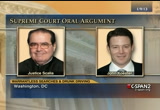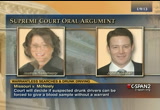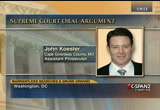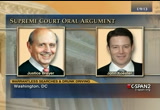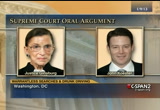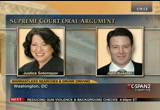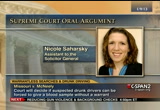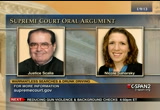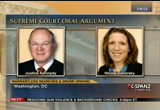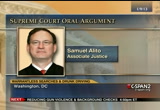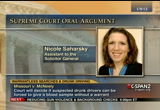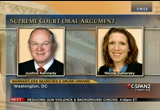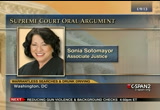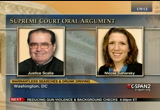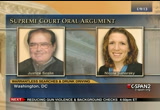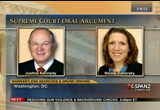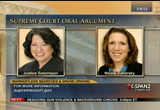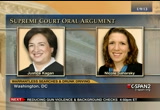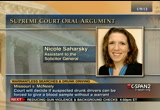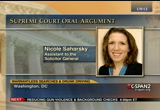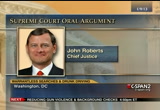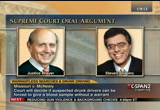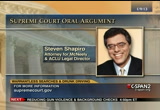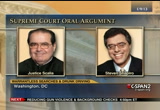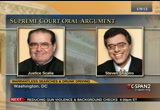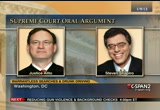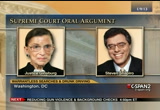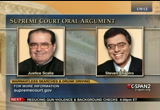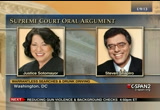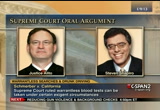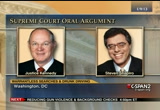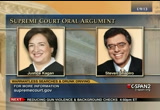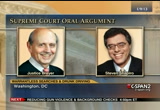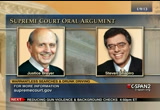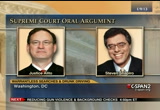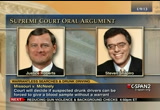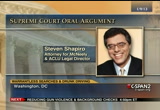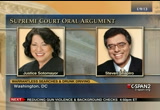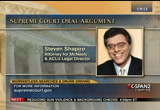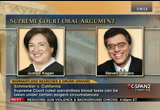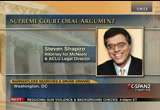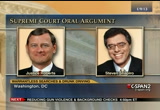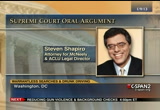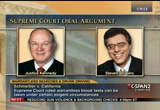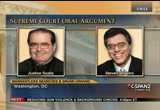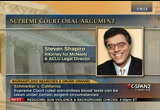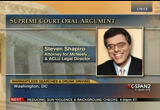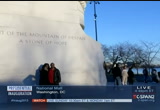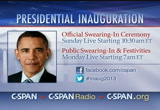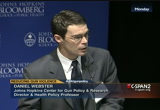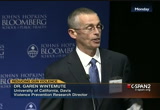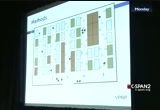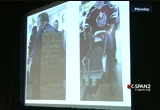tv U.S. Senate CSPAN January 18, 2013 12:00pm-5:00pm EST
12:00 pm
exceeded our amount of cash on hand and extended our authority. congress had to appropriate over $9 billion so we could have enough money to pay the claims off. who pays the interest on that? who is ultimately saddled with that debt if the insurance policies never paid that off? you, the taxpayer. ..
12:01 pm
>> win the private sector says the risks and exposures to flooding is greater than our ability to make returns for our shareholders, first of all, insurance companies are not evil people. they have a job to do, to manage risk in such a way that they can provide coverage at a rate which they pay out less than they take in someone he gets generated to pay shareholders to give them the best in the first place, right? and they said with flood we can no longer do that. our exposure is greater than the potentially return on our investment and, therefore, we cannot continue to invest your pension, your retirement plan, your bonds and your individual funds in this risk anymore. because the exposure is too great and we are going to lose money. very capitalistic approach.
12:02 pm
the problem was you had so many mortgages that were now exposed that it was going to create a potential second impact and that the exposure to all the institutions that were now leveraged and those policies would have no coverage if a major flood event occurred. therefore, the government stepped in to provide flood insurance to ensure that those mortgages and all the investments were covered against this hazard. a noble idea. forcing governments were very responsive to the people that were selling that flood insurance to did like pay a lot of money for it. so we tended to set rates below which supported the risk. now, the problem with this type of investment scheme is it's like a ponzi scheme. it only gets exposed when disasters happen. on a day-to-day basis, year-to-year basis, as long as you're dealing with those
12:03 pm
expected quote unquote below 100 year event, which i have no idea however we started calling something 100 year events that started happening every month. the other thing, we have two problems. we can't figure out how to deal with risk and we can't figure out how to communicate. your chance to buy a lottery ticket and winning is less than getting hit with a flood -- flood. most people go out and buy lottery tickets. you would be surprised how many people don't buy flood insurance. we don't do a good job if people don't do this. but the challenge with flood insurance is we have now build a program which congress recognized in the reauthorization act, we are subsidizing a risk below market rates, unintentionally, creative dynamics where we are not mitigating that risk. we are actually continuing to build and fight and argue over flood rate maps of allocations, but we are underwritten of this
12:04 pm
risk for so long with such a low rate to make it affordable, you, the taxpayer have absorbed and are not responsible for extremely large portfolio policies. and that we have reached a point where congress has we need to move these now away from affordability to actuarial sound. that's issue said than done. when those new policies, the first thing you hear is poor people can't afford to live with their living. you will price them out of their homes. so they will be i think more issues of how you balance that, but the flood insurance i think is just one example of the challenges we have in this country, how do we manage risk? and from the standpoint of a taxpayer, we assured make our investments, and which we accept exposure to the benefit of the nation? the problem i have with flood insurance is people that benefit
12:05 pm
from that are those that have the policies and can live in places most of us only dream about living in. you've got to understand there's a lot of people at growth and and live in areas subject to flood. they are not benefiting from being on the coast. one of the side effects is your subsidizing housing in coastal areas where many of us cannot even afford to live there, much less visit on a frequent basis. yet you underwrite that risk. do you get a return on that investment? are you benefiting from that? is there enough tax generated in the economy to offset that? and would disaster occurs are you on the hook for off infrastructure and everything else that may be required to rebuild that community? and asia return on that exposure -- is your return greater? as a taxpayer, the answer is unfortunately too often know. we have subsidize risks to the point where as long as no extreme event occurs, it seems okay.
12:06 pm
but when the extreme event occurs, you are now exposed to much greater costs without necessary generating revenue or other societal benefits off that risk. now, during the '70s and '80s and through the early '90s, went a lot of growth was taking place in coastal areas and other vulnerable areas, very few storms were occurring. frequency was down. so the allusion was i have lived here for 30 years, this never happens. welcome the problem with climate whether it's 30 year cycles are like an eyelash in understanding how big systems and dynamics work. not talking at any of the forcing issues, and now we find ourselves in this period of increased activity and you are sitting on top of events just cascading, reoccurring impact where we have the whole issue of whether in vulnerable areas with increased population densities,
12:07 pm
with decreased resiliency, with supply chains that were built for just in time with very low slack or get go to make up, and very few fallback situations. and then you accelerate and increase the frequency and duration of events that occur. in the last three years i went from the worst flooding, the worst tornado outbreaks, 500 year flood event national, all right, and then i go to the worst drought, and impacts of drought which people don't -- people underestimate droughts. drought probably cost more than sandy will in the long run because of the public sector. fewer games, and sandy is like, was a hurricane and then just whatever you want to call after that, that's a big debate. but we're talking about manhattan, want you to think about this. people are talking at sea level rise in inches, maybe a foot over decades.
12:08 pm
sandy produced storm surge of three to four meters, or over 12 feet, in one of the most densely populated areas in the united states. and everybody says, i didn't think this could happen. i'm like, well, i've got pictures in the '30s when they were flooding the subways back then. it just doesn't happen very frequently. we had -- all of their imaging equipment in the basement. it makes sense when you don't deal with storms every year, it's much easier to shield, it's isolated, and it's a great space putting that type of equipment. now if you're getting hurricanes every five or six years you wouldn't have built there. if you hadn't had a storm since the series of any magnitude, made perfect sense when you did. we are not going to rebuild it that way. this is the last part, from the science perspective.
12:09 pm
here's my ask. who's making the decisions about where we build, how we build? and if in a summit with the united states you're going to think it's the federal government. no. some of you might think it's the state government. not really. where do these decisions get made? local officials. whether their city or county commissions, land-use planning board. this is where the decisions are made every day wear, added up, the risk exposure occurs, but on a day-to-day translational basis you probably don't see this. but this is where decisions are made about where we build, how we build, types of building codes were going to enforce. right? yet many of these officials under tremendous pressure, particularly on the downturn that generate revenue how well the generate revenue? jobs and growth. have you ever seen anybody running for office thing i want our community to get smaller? it's always jobs and growth. that's like a mantra. that's how we go tax bases.
12:10 pm
they're having to make decisions that oftentimes our short-term, very limited windows on what this risk is. we do not give the good tools to go, is this investment, is this construction, is this development going to return more money to my taxpayers or have i created a hidden exposure because once we have approved it is, we transfer that risk from that growth, from that development, those people living there, we will translate that to the other taxpayers. are they going to get enough benefit from that? this goes back to we don't have a good way of managing risk because we don't give local officials good tools to say, these decisions make sense. these decisions could be mitigated. we may be able to do somethings to allow this to occur and not transfer excessive risk. and oh, by the way, the taxation and the jobs offset. but many officials don't have those tools. so we repeat key decisions made time and time again in the name of short-term gains where risk
12:11 pm
may be in transfer to the public without a clear understanding of are we getting enough return for the. the second thing is, when we talk about climate change, have your debates and have a nice day. i've got to deal with adaptations. whatever you're discussing, something is out there and it's been going on and accelerating. we are talking about many cases, and criminal changes, and are going to a few events. when we look at mitigation strategy, i think we in this -- has been so much time looking at things like flood insurance rate maps and trying to normalize and look at things actuarially. we've got to take a step back and go, or how this time we quit looking at just building content and building value and looking at this like insurance and try to figure out how to mitigate that and go wait in it, this is a critical piece of infrastructure community, like a fire station, a school, a key utility, should we not put more mitigation and that against the
12:12 pm
maximum impacts lex again, manhattan, we're talking sea level rise projections of inches, right, overtime may be afoot. what are we talking about in a hurricane? 12 to 15 feet. what am i going to mitigate against? the sea level rise or the maximum theoretical consequence of a catastrophic disaster? can i do this for everything? absolutely not. would make sense financially. what if we started looking at the functions we deal and how to build resiliency in the functions versus just looking at we've got to do the whole community going we are already there, it's already built. how do we mitigate the most critical functions? and then the last thing is, i love this from resiliency because it's sort of like, depends upon who you ask. it's like one of these words you use in a lot of ways but no one agrees. but resiliency, i make this joke because it's not a correlation
12:13 pm
that is one-to-one, and so in the academic world there's a lot of, when i say this, people cringe and say that's not. but i think it's an important point. i think efficiency has become the enemy of resiliency. and i think this is something that we have built economic models for every reward, return on investment in such short periods of time that we have force ourselves into developing systems that are just in time and so weak to ensure profitability that we do not understand and now see the consequences of shocks to the system where the system no longer has the ability to absorb and manage. they have become so brittle that the destruction and demands make the systems almost guaranteed to fail in these types of events. so how do we start talking about supply chains and how do we start talking interdependence.
12:14 pm
when you start getting into cyber, this is where it really i think people start seeing cascading impacts. what we saw in japan was this cascading effect of a singular event cascading into him multiple events, adding to the second and third order of events to become more impacting than some of the initial impacts. at least lyrically. -- politically. so how do you look at systems and look at resiliency in the face of types of events occurring and tried to look at how do you sell, how do you show investors, have additional boards of directors that you need at that balance between those lean, efficient, very profitable systems, and where are the tipping point that your resiliency customer, goodwill, regulatory impacts without weighing on things you need to do to build some capacity?
12:15 pm
because again in the united states, most of our critical infrastructure delivery is provided by who? investor-owned companies, right? whether utilities, food, supplies, health care, a lot of other things now. so you can't just go in there and say, investors need to suck it up and you're going to pay everything. i think again we oftentimes are looking at such short windows of return on investments that we have potentially accelerated the vulnerability to known hazards by building systems that are less and less resilient. and again i could go back and people will say, it wasn't this bad in the '80s and '90s, what's happened? why is it so much worse? you know, we are technologically come we're doing better, smarter, faster. why? a lot of a lot of times it's a simple answer. fewer people, fewer resources. not a lot of slack in the system. not a lot of excess capacity. that doesn't make you money so it's been cut out.
12:16 pm
you are more vulnerable now but if that's the model we are in, then how do we as a society build resiliency into that? is it government? is a subsidies? how do you do that? so those are my asks. thank you. [applause] >> did i mention he is an amazing speaker, to? while i'm about to ask some questions here, icq members of our first plenary art in their seats to it the other members of plenary one can come and take their seats year, then we will be ready to go for plenary one. this whole idea of resiliency and sustainability was something that we actually had a special preconference meeting about four
12:17 pm
the united states if i met a protection agency yesterday, symposium on revealing -- sustainability delving into the core complex, that we often think of sustainable communities and sustainable systems as steady-state things when, in fact, in a world where major disruptions are frequent and severe, sustainability must be something that is dynamic, must be something that is resilient and responsive to dramatic changes in dramatic impact. and so the results of that symposium were distributed to you this morning, and will have parts in some discussions displayed at parts this afternoon. there was a question about the framework for action that margareta mentioned in her remarks. so i'm just going to ask that
12:18 pm
question. it is -- well, in japan near kobe. i assume that's where the framework for action was developed. i want to know some of the questions that you have been asking. and i've got about 10 times more, in fact 20 times more than i can ask is i'm going to ask some general questions you. the first one comes out, something both of you mention. this is the issue of funding changes in communities that make them more resilient. neither one of you control budgets that can bring about
12:19 pm
changes to the scale that are required. and so, what can you do and what happens to get the funding flowing where it needs to change impacts? obviously we are also but what's happening here in the u.s., but it is even more acute issue in poor countries around the world. so craig, you've got the microphone in hand so why don't you answer first and then hands the microphone to margareta. >> i think the challenge is, particularly as you see what's going on right now with the funding for sandy, a used to be the assumption of the united states is a big disaster happened it was always easy to get money after the fact. it was almost impossible to get money prior to event occurring. that's not the case anymore. even getting money after a disaster, given the current budget climate is extremely difficult. so i think, again, it comes back to the preponderance of these
12:20 pm
decisions over time are made at the local level. yet almost everything we're targeting is a national policy. the united states federal policy doesn't dictate a lot of it. we basically use incentives and disincentives through taxes and great fun. but we're real decisions get made is at the local level. what i'm trying to get our flood insurance folks to look at is we've got to quit selling mitigation as a gloom and doom. we really need to look at it as a transference of risk. that you want to make good decisions for your community. you don't want to say i'm not a no broker. but what did you think is unique to give local decision-makers better tools that when they get high pressure to build because of jobs, they have the tools to say this makes sense, this doesn't make sense for community, the risk is too great. or by doing this medication we can manage this risk and benefit
12:21 pm
for that community. i think we oftentimes, and this is true in our flood insurance policy can we have a one size fits all and it's almost binary, yes or no. our preferences don't grow there. the last time i checked the ocean wasn't moving. people want to be near there. all right, fine, but can we do in such a way that doesn't transfer extreme risk back to the taxpayer without seeing some benefits? should we allow that construction without increasing code requirements? we still have parts in this country were it's like a checkered board. you can have a million dollar home next to a house built prior to any coach in the same neighborhood and we saw what happened in sandy. the ones built pre-flood insurance rates were destroyed but the ones built afterwards had damage but basically power back on, get this and picked up and taken of backing. that development may be acceptable for the risk because the tax base it generates and, in fact, many of them are secondary homes and have low
12:22 pm
demand for service. but, unfortunately, most people don't have the tools to make those on a repetitive basis across a lot of communities, driving it toward managing that risk more effectively. >> if we look at some internationally, even in countries that still low income countries but very high risk, there are many countries were wisdom prevails. i don't know if there is a representative of the philippines here in the conference, but in the philippines, interests and, the government is taking why parliamentary, very far-reaching system of transferring decisions and local levels. in fact, so large for the financial sources resources made available they could really be used in the time frame that they
12:23 pm
were offered. all that to say, it's not just money. it's also of course some of the policies. it's the direction. it's the knowledge and a clear sense of the priority. so you know, there has been a lot in the last few years, a lot of mobilization of local government. i don't know if some of you are represented here, and the practice of working directory with local government is very effective and it comes to really concretely how do you manage risk? how do you set priorities at local level? if you're a citizen in a local, and the town or in the city, actually can engage in the risk identification and risk management, you have a very different dynamic. and a potential to build alliances locally for mitigating very obvious risk, and together to reduce them. one of the effective proponents
12:24 pm
of managing local risk is a governor who has been very clear all along. he's been so sophisticated economist. he says i never talk to people in my community about risk. i tell them that our goal is to achieve, in his case, a millennium development goal, but in order to do that you have to invest in risk reduction. he put away 10% of its annual budget, local income and other sources. and very consistently has been on this. and it makes a change. so it's also, it is money of course ultimately but it's also the choices you make, particularly if you're in the beginning of a rapid economic development. what do you do with your infrastructure? where do you let your town develop? how do you deal with the poverty
12:25 pm
issues and the most vulnerable groups in your society. these are the concrete questions at the local level can be discussed. if you think about the international perspective, international development aid also given priority to strengthening risk reduction, the short answer is no? and you can say that goes against what everyone is talking about, yes. policies are changing gradually, but i don't think that the flow of resources is anywhere near what the talk is generally of how important it is to reduce risk today. on the other hand, maybe i should also say, in comparison to national resources, national generated resources, in comparison to foreign direct investments in poor and middle income countries, the financial resources that they can obtain
12:26 pm
through the assistance our minimum. so the most important things that we're really working on is what a national choices are here and that's why we also invested quite a lot of mobilization in getting business involved, to see it is in their interest, that they share the responsibility for how to invest and less risky environments. and how to reward those local governments and governments that actually take large responsibilities for mitigating risk, with their business and investment. >> thank you. we have time for just one more question, although i've got probably three hours of questions in front of me. this next one combines three, four cards, questions from the audience, and comes under the title of damned if you do and damned if you don't. and this is about -- one part
12:27 pm
was what happened to poor people who can't afford to own land? and craig, you dealt with this, and margareta also. also, some of these vulnerable areas are also economics where factories and infrastructure, corporations are in these areas. and that's part of what drives people to be there. so there's also and industrial and economic aspect to this. in part of the challenge about helping or not helping is an ethical question, as well as a legal question. so i would like each of you to just address that briefly if you could. >> here's how i would frame it. i've been into me places where i
12:28 pm
call them the proverbial one company down. but it's in the flood zone. and the workforce lives in housing, low to moderate income, is what is affordable there in the flood zones. when the flood comes in and wipes everything out, there's no tax base, there's no workforce and the company closes. then local officials go what happened? this is what i'm talking the resiliency. i think again we've got to put this in terms of dollars. and what those impacts are. i look at resiliency this would. and i think part of what you hear is you will hear this all through the sandy recovery. fema is telling us we can't do this. you can build there. we can do this. we can't do -- and we know better. i'm like, fine, then accept that you're not going to have flood insurance because we have to make sure that risk is covered. that's why these requirements are there. but understanding that, as long as someone else is telling you
12:29 pm
you've got to do something you're going to look at every way to get out of it. ignore it, or you're not really embrace it. let's change this around. i don't want you doing it because someone else told you to do. i want you to you because you look at you tax base, and for the united states our local officials its tax base. without taxes best of services. you may hate taxes, you may never want to pay taxes, but the bottom it is for governments in the united states, for local and state governments without tax revenue, you cease to fight essential services, right? develop the tools to give them how to look at the resiliency of the tax base and their exposures. understand after disaster is much easier to make big financial changes. but in small incremental changes, how do you look at decisions you're making to say that if something happened, our tax base is resilient enough we can survive. or we are so exposed to this
12:30 pm
that if it happens, we need to understand what those consequences mean. and so the issue about rebuilding affordable housing, maybe is not a good idea to rebuild it with their most affordable at. but you can't zone and out of your community. this is one of the things we've seen is what i call the benign neglect, where local officials have areas of poverty and in the disaster they say that's pretty good land and if we can get all those folks out of there, move them somewhere else we can redevelop the area make more revenue. about issue move your workforce away too far, what happens to your economy? it try something that they get, tax base. and it may be cold hearted but i think in a pragmatic way if they don't understand what it takes have a resilient tax base in the face of the threats they are and whether current exposure looks like, most of them have no clue. we talk about these events in the abstract. i would like to break it down and say until this flood occurs at this level this is what your
12:31 pm
tax base looks like in three or four years. how will life look like then? what are the steps you can build resiliency. this is the other the are talking about fema, talk about the whole of community. not the easy stuff. not the popular stuff. but all the stuff that takes commuters are made up of and how do you make sure that in building your community, you are not zoning out, pricing out or eliminating affordable housing. the real answer is, it may not be possible for people to rebuild and live the life that they live for generations in the same spot. particularly when they have flooded out the fourth, fifth, six times. many of these people actually are trapped. because they can't afford to move out but they don't have the resources. oftentimes when we do buy it programs the first time not a lot of interest. second or third time, they want to relocate. they want to get the families and more stable in front. so i think again we've got to
12:32 pm
sell this on the idea of resiliency in a turn that local officials get that is immediate and short-term, tax base. taxes don't come in. you don't have services, right? and it is something that is tied to a lot of a lot of factors. will try to get people to look at, but they can almost be overwhelming. if you start driving tax base in how decisions are effecting the future and what your vulnerability disasters or, based upon the resiliency of your tax base, it allows us to introduce a lot of these other issues in a way that doesn't -- were not telling you, you can't do something. we are giving you tools, and what your exposure is. and with a folder with looks like in making your budgets and decisions. >> i am always struck with where in the world you go, how similar
12:33 pm
people reaction to disastrous event in their community, and one of the things that no matter where you go, people don't want to leave their home. and i quite frankly i think emotional reaction is exacerbated by the disastrous events. that's what becomes -- it's an emotional reaction but it's very strong, and i remember i met one of the mayors after the earthquake, and he said immediately after, one of the communities that was literally wiped out on the coastline, in front of a very high mountain, and he said immediately after the disaster, 80% of the people said we are never going back. we are ready to move up the mountain. finally that number kept going down and more and more people
12:34 pm
forget, they prefer, doesn't happen again. the local officials left alone, it's an enormous challenge of dealing with people and their reactions. so building back, how you build back depends on your capability to be with a time with your community and economic pressures, and neither too fast or too slow, but it is never the right pace. we know that, of course. but these are decisions we take locally. second point is, you know, i think all of us say disasters are dynamic. they are never the same. what it actually means is we are not very inclined to think about moving human settlements, moving large data sets. but -- in another tent it will
12:35 pm
look very different to that was the experience of the many companies in bangkok who are flooded or nine weeks. 25 years ago when they established, sure they did the risk assessment, and it was very positive signs. they were close to population labor force. they had transport on the river. that clean water, everything they needed. now are they going to move? no, they're not sure. so dynamics of this, how can we -- so not only of course disaster events to be mitigated, but actually think that about the longer-term option, not the ones that are forced upon them, buying a necessity of a fairly rapid reconstruction is probably an opportunity that we missed too many times. and my third point is, i think this is typically maybe for the western worlds in our attitude to discuss is to put it behind us, forget and move on.
12:36 pm
what i learned in japan is that you have to nurture your disasters but you have to remember them. you have to keep learning about them. and i did remember the governor, something is after the earthquake, the year before the other is good, he said in a memorial that i'm quite worried that people are beginning to forget the disaster. and that makes us less resilient to deal with the consequences. unfortunately, for the people of japan they then head the answer to that concern. but i think there is a strong lesson that we must not put them aside and forget and move on. we have to learn, relearn, actually actually remember how you deal with them, how you rebuild and what mistakes you made, of course, to constantly learn. >> margareta, craig, thank you very much. [applause] >> i, barack hussein obama, do
12:37 pm
solemnly swear -- >> this week in the 57th presidential inauguration as president obama begins his second term, sunday the official swearing in ceremony at the white house live shortly before noon. monday the public inaugural ceremonies with the swearing in at noon eastern at the u.s. capitol and other inaugural festivities including the capital budget and the afternoon prayed. live all the coverage begins at 7 a.m. eastern time on c-span, c-span radio and c-span.org. and throughout the day join the conversation by phone, on facebook and facebook.com/cspan, and on twitter, #inaug2013. >> coming up live this afternoon on c-span, a discussion on immigration, trade and safety along the u.s.-mexico border.
12:38 pm
that will start at 4:30 p.m. eastern. live on c-span. >> we have more now from this conference hosted by the national council for by the national council for science and the environment. a discussion looking at the impact of the 2011 earthquake off the coast of japan. the earthquake triggered a tsunami as was the meltdown of the fukushima nuclear power plant, and also robert willard who serves as president of the institute of nuclear power operations. this is about 50 minutes. >> i am pleased to note that this morning's proceedings are being broadcast live on c-span. so if any of you in the audience were your friends and family believe you're in las vegas gambling, and you're embarrassed by the fact that you're here trying to make your community
12:39 pm
safer and save lives, keep your heads down. the plenary are moderated discussions, very interactive. again, questions from the notecards will be picked up by the staff. i will pass them. our moderator today is jon hamilton, correspondent with national public radio. on the stage -- not quite in order, but retired admiral bob willard, head of u.s. pacific command, the time of the events in japan, is now ceo of the institute for nuclear power operations. and please excuse my pronunciations. koji tomita is deputy chief of mission at the embassy of japan here in washington, d.c.
12:40 pm
yoshimi inaba who is chairman of toyota motor here in the united states, and finally, doctor timothy mousseau, professor of biological sciences at the university of south carolina. thanks. >> so welcome to the session. as was said to my name is jon hamilton. i work at national public radio, we are looking at disasters is an unfortunate large part of what we do. and it has become almost routine in my organization to everybody knows what to do when a super storm is headed for manhattan, or an oil rig explodes in the gulf of mexico, get on the phones, get on the internet, get on airplanes and, of course, that includes reporters like me foresight reporters who work at a science desk. so in 2011 when we learned about a massive earthquake off the coast of japan, science reporters at npr were involved from the beginning. some of my colleagues were tracking seismic readings.
12:41 pm
other people were looking for measurements indicating the size and extent of the tsunami. and all that made sense to us because at first we thought this was a story about an earthquake and the tsunami. and it was almost as an afterthought that somebody came to me and said, you might want to look at reports about a nuclear power plant that might have been damaged. and, of course, the fukushima play became a major part of the store, not an afterthought. and i would end up spending a couple of weeks in tokyo trying to explain to our listeners what was happening at that plant, even though i never got within 100 miles of it, for obvious reasons. so this was an example of how one disaster can trigger another and another. and it was an example of how a disaster along one stretch of coastline can affect an entire nation, and to a lesser extent, much of the world. so the people sitting with me here today know a lot about the events of 2011, and they've had some time to reflect on what's happened.
12:42 pm
so let's hear from them. and i'd like to begin with mr. willard, and i'm curious, before you begin work in nuclear power, of course, you've been a commander in the navy who responded to a lot of disasters. and i'm curious of you, what made this one different? >> thank you, jon. i think first and foremost, the magnitude of this particular disaster, disasters are not uncommon. man-made or natural. and in charge of u.s. pacific command with responsibilities from the west coast to the united states to the midpoint of the indian ocean we were responding to disasters more or less on average once every eight weeks. and there are volcanoes, mudslides, tsunami, typhoons, cyclones, vast. and you heard the referral to
12:43 pm
the 2004 tsunami that emanated from earthquake south of indonesia and killed over 200,000 people. but the magnitude of what occurred off the coast of on shoe was unprecedented in any of our experience. it was an earthquake that was once in our imagination, and hundreds of aftershocks. it wasn't one tsunami. it was seven ways, and the one that struck fukushima daiichi was 50 feet high. and as a consequence, series of nuclear reactor accidents that occurred subsequent to that added a radiological dimension, a dimension to this disaster that was unprecedented in any of our experience.
12:44 pm
and you know, so i think the magnitude, and it happened in a highly developed society, resilient generally to earthquake for sure. but along a coastline that couldn't contend with the magnitude of the tsunamis that were subsequent to that. so really remarkable in terms of size and scope. >> okay. next, i think it would be interesting to hear from mr. inaba. how did these events affect toyota? >> well, first of all, let me thank you to give us an opportunity to talk about and how we prepare and better manage disaster. the events in march, 2011 was devastating to japan. and so was -- [inaudible].
12:45 pm
immediately after earthquake and tsunami hit in japan, our president established a companywide emergency task for force. to address, assess the situation and take immediate action. and our priorities were very clear. first of all, to provide assistance in the affected area. so we quickly formed a convoy of 87, 11 time trucks with water, food, medical supplies, blankets and so forth, and sent it over. and we sent after that also seven, 21-ton trucks with only water. and that really water, saved their lives.
12:46 pm
so this is immediate action that they had taken. secondly, to assist in a speedy recovery of the effected area, we are proud to say that our people have helped what is a very difficult recovery for the area. over 200 employees from 15 toyota affiliates engaged volunteer basis, recovery work and played a leading role in area coverage -- recovery of the disaster area. and, finally, third one is to our business, to resume to the production in japan as soon as possible. we had already planned to form a third days of our production site in japan.
12:47 pm
in an area which is on an island, and then that specialize in -- [inaudible]. we specialize on small cars, but immediately thereafter, to really help revive the economy there, we accelerated the efforts and to call the pension plans and everything to help ensure the employment is being created, in all these. our headquarters in japan are not located in that affected area. but still, as many as 660 suppliers were in the affected area, and some 450 dealers, too. and one of the very critical
12:48 pm
example after we find it is there are two major suppliers, not in terms of size, big, necessary, but the very critical parts such as integer hills, which affected -- paint materials, which affected detroit '03, '04, not having enough materials to a certain colors. that is one of the very interesting examples that we found. but the other one is much more major in magnitude, which is the company which produces semiconductors, having 30% of the global market share, which affects all the microcomputers of the car around the world. and that is the most critical part of that. initial assessments for the
12:49 pm
recovery of that part, or company was very grim, and we estimated about eight months of production being lost and disrupted. but with a tremendous efforts of all the team members, now, for our company, from other companies, suppliers and leaders, they were able to start, restore the production within four months. which is twice as fast as was anticipated. so that was sort of the situation we were in. >> an amazing effect on one company, though the company wasn't headquartered in the effected area. so moving out from that, let's talk about the effect on japan as a whole. mr. tomita, i'd be curious if you could talk a little bit about how japan can when it began to fully realize the
12:50 pm
extent of all the things, the whole cascade of events and what the response was. >> well first of all, i would like to thank the organizers for giving me the opportunity to be part of this process. as you know, the whole japanese nation is in grateful for all the support extended by the people of the united states. and while we remain -- share expenses. this is a very important, to do so. and in terms of responding to what this panel is titled, cascading disasters, i can point to several -- apart from this sheer magnitude, which a party
12:51 pm
been mentioned, the first study we had was, this is a case where we saw the very structure of local government was wiped out, literally. in some towns, in some cities was even difficult to identify who was living in that city. [inaudible] so even we had national government had policy that there is no means to do so. so that was one of the most difficult tasks, was in that aspect, the president -- present of u.s. forces, i would like to express my gratitude, the role
12:52 pm
played by the u.s. forces. and apart from this initial discovery, our efforts been compensated by several factors. i will point to several of them. first of all, -- [inaudible] the progress of going back was impossible. but as we make progress, going into the next phase, we start to be encoded with a sort of interest. in the previous section, one of the keynote speakers talking about peoples tendency to want
12:53 pm
to go back to their original homes. this is not just animalistic. all the people living among many people living in coastal areas were engaged in fishing. so once they start to lose their library, they want to go back to their original homes, close to the coastline also wanted so forth. but this is the area where we have -- huge tsunamis but at least one in the center. so it makes sense, whole community to the higher ground. but as i said, create conflict with the interests of those affected people. that's not possible. and the third studies we
12:54 pm
encountered was, japanese people have a culture -- [inaudible]. i think many of you were deeply moved by the people comforting each other and helping each other in disaster. but when it comes to work out political consensus of how to share the inevitable burdens, this process takes a lot of time. for instance, the question of -- [inaudible]. these type disasters create a huge amount of -- far beyond the capability of the local community. so we need to get -- [inaudible]
12:55 pm
involved. but when we tried to make progress, not in my backyard, but this process takes time. and, finally, every time you have this disaster of this magnitude, you have week contracting natural government it seems. so it sometimes engaged public on many of the important issues to the nuclear policy is case in point. so those are challenge that we are faced with. >> thank you. so, taking his cascade to logical extreme it can we get to environmental impact. and so i'm hoping come you been
12:56 pm
studying how fukushima has effected the assignment and maybe you could give us a summary of which have learned so far. >> yes, thanks, jon. i want to thank the organizers as well. you know, we first visited fukushima in july 2011, shortly after the disaster. and spent about six weeks there since that time monitoring the movement of the contaminants, and look at the effects on the biological communities. everything we've learned is new. of course, there's never been anything quite like this. there was chernobyl 20 stitches ago, and we worked quite a bit on chernobyl the last decade or so. but the fukushima if it is quite different than likely it was smaller than chernobyl a lease on the terrestriterrestri al psycho and so we're thankful for that. but this was the things we've been looking at our how are the birds affected, how are the microbes affected? are there measurable impacts of the contaminants that are being
12:57 pm
spread through the environment? and what are the civil liberties and differences of let's say chernobyl and different areas of radioactive contamination? the first set of results were very preliminary, published, have a couple of things published related to birds abundance and diversity as will some of the major insect groups. the most striking thing come from that is the level of variation among different grou groups. birds and butterflies, for instance, showed very strong and rapid responses to the contaminants, which we have also seen at chernobyl. but many of the other insects for instance, did not. to be directly and immediately affected. dragonflies and grasshoppers, and seem to be there about the same numbers they were the year before. we have since come back for a second year of monitoring, and the pattern is changing. we have to publish those results
12:58 pm
yes, i can't give you too much. >> maybe a hint of? >> things have not gotten better, i can say that. so what comes from, the message from these observations to us are that we need to be investing in some of the basic research to continue this kind of monitoring that's really the unique event, a horrible event that provides an opportunity to develop an understanding of the consequences for wildlife in ways that just are not possible in any other scenario. >> could you quickly just characterize the environmental impact, as much as you know now? you started chernobyl so many years, compared chernobyl and -- >> well, there are many similarities and the differences. the similarities are that we have vast quantities of radionuclides spread at a landscape scale across the entire. the landscape scale at chernobyl
12:59 pm
was much larger. there's several hundred, several thousand square kilometers of highly contaminated terrestrial ecosystems, whereas in fukushi fukushima, it's really only three or 400 kilometers, square kilometers that are really highly contaminated. and so, also in chernobyl because it was a nuclear fire that burned for 10 days, it released much greater diversity of radioactive develop and including quite a bit of plutonium that were also scattered -- scattered across the rugged the these other radionuclides have different consequences for organisms that are exposed to them. also, plutonium actually one of the developing isotopes of plutonium was plutonium to for one, which actually converts into -- 241 which is also very biologically and will be around for thousands of years. were as in fukushima, what we
1:00 pm
1:01 pm
one of the most detested countries in the world, and in that sense we are pretty much prepared. but one of the lessons we learned from is there is no guarantee of a natural disaster. we have boundaries of assumptions. so, actually we need a lot of help from the countries, and actually 60 countries came forward with various types of methods. and as i said in my previous remarks, the progress the u.s. made available a difference.
1:02 pm
[inaudible] so was the u.s. government operational for the nuclear disasters in fukushima. >> i want to move along here to another topic which is what other places can learn from things that happened and i'm curious, mr. willard whether you think there are lessons for, say california, a place that has nuclear reactors along the coastline that could be available. are there lessons and have people learned of them? >> i think as fukushima began to unfold, the nuclear industry's global lee began to respond. quite honestly, the of u.s. nuclear industry very aggressively to begin to inventory its spare equipment and look at its own ability to
1:03 pm
withstand an event such as japan was experiencing. there are myriad lessons that have been learned and the institute of nuclear power operations was requested to assist in gathering the lessons learned from fukushima and the other nuclear sites along the coastline and to share those broadly in the u.s. as well as for the world organization of operators globally. so, fukushima has been at the forefront of dialogue throughout this industry. quite frankly, the idea of the beyond design basis, external event such as japan experienced has ranged in terms of lessons learned just beyond the energy sector and the nuclear industry
1:04 pm
to many other areas that could experienced similar events. >> a que. mr. inaba, going back to the effect on the auto industry, are there any changes in return of the resiliency of supply chain or things that have changed since fukushima? >> yes. i think there is a tremendous change taking place. i think we have probably about 400 tier one suppliers but anything beyond that, tier two even down to tier 5, we assume that the supply chain is like a sheep of pyramids and the tier one suppliers take share of the two, three and four out what we found in this case especially the same conductor company it is almost like a spindle, and
1:05 pm
therefore we have to make an infestation of all of the supply chains all the way down to tier five, so this work has started and what we found is there are about 2,000 critical parts where there is only one single supplier or juan special material for use and therefore there is no replace a devotee on stuff like that. so from then onward to the end of this past year, 2012, we have done many new things. when we can find additional locations of the same supplier, we did. where we can find additional or alternative suppliers we point to them so that for the is there
1:06 pm
or at least two companies with a different location or company that could supply the parts in case of emergency and disaster. in some cases is a very tricky volume necessary therefore against the production systems, the gps principle that we ask them to store four months of supply in the process, cities are exceptions for necessary instead of zero inventory in the process we ask them to store, and we also started doing standardized parts even extending it to industry which isn't easy because there is always the development, so it is
1:07 pm
slow the certainly going on to have the standardized part so that we can have an economical solution for the alternative sources of parts and stuff like that. we have completed this process on the japan based supply about 90%, and i think the u.s. or north america is the second-biggest production base and they are moving along to give the example of japan. now they are supposed to finish this complete work by the end of march. so i must say to you that it has become a stronger and better company. >> thank you. let's go to some of the
1:08 pm
questions from the audience. the first 1i think perhaps mr. tomita and willard would be good people to answer. does it make sense to rebuild power plants in communities in an area that has been destroyed by a tsunami? do you want to go first cracks mr. tomita? >> as i mentioned in my previous remarks, it can take time before we can come up with the new set of policies and combined experiences, and actually only two reactors, and we have had
1:09 pm
politico in the recent weeks we have a new government coming in taking and never look at the nuclear policy. so, it's for me to say this definite for the specific questions there are two aspects. one is we are going to have double regardless independent of the estimates of the location of the nuclear policy. so, if any location has had the
1:10 pm
experience of being struck by the natural disaster that would be, that element would be looked at very closely. the other thing is the political factor. if a given area is approved to disaster it would be more difficult on the location, so those are my observations. >> i think that was well stated. you have an area that is prone to disaster and the defense and death of that industry can achieve in engineering. the site is insufficient and it wouldn't make sense to build a site so i think it is a rather
1:11 pm
simple question and what was learned in this particular instance was that the assumptions, the design assumptions, the factors with regard to externals defense that could occur didn't match the event that did occur. this was a once in a thousand year event that no one imagined, and the unimaginable happened. so the thought that must go into the engineering factors associated with construction in any disaster region needs to be executed very well. >> next question is a net fishery. the question is what is or should japan do to assess the
1:12 pm
long-term state of contamination and isn't affected? >> that's a great question and especially given the size of the fishery and the moment the fishery and the affected area is closed and there was a recent paper not so long ago showing that the level was sent really dropping as quickly as people had expected and the reason it wasn't expected is because we know little about the fate and transport of these. it's the first system of the sort, and we haven't really developed the models were the effective tools to predict what the consequences and risks are. so in terms of the fishery come at the present time, we really don't know when that fishery is going to be reopened. we know the kind of exposures that many of the populations are
1:13 pm
seeing are potentially deleterious or in packed full to the populations. we still don't know really what the potential public health ramifications are in terms of the spread of these contaminants as well. so again, getting back to adjust the level of ignorance that we have concerning the long-term impact as profound, and i would argue that we need to be paying very close attention to what is going on and how we might be able to predict the future. >> okay. next question is about training and coordination and the question is is it sufficient, and might be interesting to get a response both from the company's perspective about whether the training is sufficient for the disaster
1:14 pm
>> certainly the lessons you learn from those disasters are now when the company said that when something happens we have a lot of natural and man-made disasters so it's a production system that learning of those experiences are plentiful, and i think it is probably shared by many associate at the same time there are some groups of specialists who specialize in this what we call further supply center, and this work has been going on within our industry, but well beyond that industry. i just give you an example of it. these groups of people are hoping for example the saint
1:15 pm
bernard project which is the housing rebuilding project caused by hurricane katrina, and they are helping to rebuild the new housing. usually it takes about four months to build it but then much quicker with the experience that we have had in the past in two months. an interesting example is that group of people went into food in hall when does the food supply and then they went into the process control and reduced the weight time from 75 minutes to 18 minutes and stuff like that. so i think those lessons we learned we have to utilize those
1:16 pm
to the good of the society otherwise you are not fulfilling this role as a corporate citizen. >> is their something that you want to have? >> i would offer the question of education and training as a potential lesson here is an excellent one. it is one of the significant lessons from fukushima if. we find there are very often training lessons learned from any number of occurrences throughout the industry. in this particular case when you think about the magnitude of the event and the such a vision that the operators of this particular nuclear site found themselves in, it was unprecedented in any of their in education and
1:17 pm
training and one of the lessons is to take that idea of a magnitude event that exceeds what we generally designed to our sites and begin to both educate what defense and depth can provide and turn to the coping strategies in a situation like that if i would be -- that may allow it level of resilience that may not have been designed into the site in the first place. this was remarkable in its scope. there was some courageous operators that remained at the watch at fukushima attending to mitigate what happened to them. obviously in retrospect additional education and training could have only helped in that regard. >> a quarter i'm also curious if
1:18 pm
you can address the communication issue that was raised earlier. the communication was a large part of a coordination with the public, communication with the world about what was happening. >> training is very important and exposed to certain weakness or the countries prepare for natural disaster. but having said that, you're not going to be fully prepared. they are not going to be in every challenge a natural disaster. so our focus should be not just a natural disaster preparation of the mitigation, and the other
1:19 pm
important aspect is that when you have a disaster of this magnitude, every aspect in the policies are tested not just the question of the disaster preparedness in the banking regulations so it's important to try to mainstream the aspect of the disaster mitigation. i think the would be extremely good, and the communication is very important. i think sharing that experience and learning from the experience from other countries will be crucial part of a reference. >> for their lessons learned about how to communicate better
1:20 pm
with what is happening in a situation changing from minute to minute? >> we can learn the lessons from our experience, but we had difficulties in the local government structure, so we are a very difficult situation in assuring the and as for the question of nuclear disaster that is a very delicate balance. you had a strike in trying to share the information we have and the need to not create a
1:21 pm
panic was a very difficult situation and we need to closely examine our experience and try to come up with the appropriate lessons if that is to continue. >> as long as we're talking about preparedness, miti would talk about if there is such a thing as environmental preparedness and if so, how does it work? >> prophylaxis is the best preparation for those kinds of environmental disasters. i did want to touch upon the education issue and mention briefly that windel fukushima radiological disaster hit, there really is a great lack of educated scientists in the
1:22 pm
community capable of tackling many of the aspects of this kind of environmental impact. we have a shortage of radio geochemistry and ecologists stemming from the fact we never thought such a thing could happen again so the emphasis in the field of dropped off. at the moment we need to train a few more folks to handle these kinds of emergencies in the future. >> the next question is specifically for mr. willard and it has to do with the mission to support disaster response and whether the budget cuts are likely to have an affect on a. >> the ability of the military to be mobile, all the things the budget contains can potentially impact the opera kildee and flexibility of the fleets and
1:23 pm
forces, but i would tell you that response to natural disasters has become pretty fundamental to our core missions within the military as the bus across all the services and the air force and navy and marine corps and special operations forces were part of the mix that assisted in japan during a very large disaster when. i think it would be highly unusual to see a lack of disaster response from not just the united states military that the military of the world. this has become such a central focus in our training such a central focus of the way in which we are conducting ourselves there is the work beyond the sense in 2004 and the
1:24 pm
large tsunami in the southeast asia region, so this is very much our core business. so it can have an impact on the degree of mobility of the military and the answer is certainly. as a part of the core business, i think you'd see a great effort to respond should natural disasters or when natural disasters occur. >> what is the current status of the fukushima plant? >> welcome our task has been to stabilise the situation, and i think that we did in that aspect, but this is going to be
1:25 pm
a long-term enterprise. the commissioning will take decades and there's an added question on decontaminating the affected areas and the whole range of political and economic questions. to start with how to rebuild the livelihood of those people who used to be living in that area and the fact they are not going to be able to get back to their homes. there are very complex issues how to ensure that people are properly compensated, and on top of that they have broad policy questions including the question of the nuclear policy and so on,
1:26 pm
so forth. so it's going to continue to be a very big challenge for us. >> we have time for one more question. the question is what is the risk of radioactive contamination to the northwest coast for all that debris we have been reading about that's been floating across? is there any environmental risk? >> we don't know very much. it's clear there will be just trace amounts of the radioactive seized on the debris because the water is soluble so this stuff will be basically diluted off so there will be very little directly attached to the material that's likely to have large biological facts but that isn't to say there might not be touches that are more contaminated. but clearly the main interest is and in the radioactivity of the debris of the debris itself and
1:27 pm
its impact on the of the kinds of activities. islamic and the related question since it came up so many times in the event and that is that some of the radioactivity going through the air, any environmental risk posed by that? >> it's still the debatable question in terms of exactly how much was deposited at the time. clearly there is minimal the position at this point in time. most of it came in the form of 131 early in the event that has a short half-life so whenever impact there might have been we are probably early on. we don't actually have a good idea that this is the scope, the monitoring that was there is the relatively simplistic and not extensive enough to really guess what the impact might be. my gut reaction is it is clearly a much smaller risk than what happened in japan. much, much smaller or as a magnitude so it's not to say
1:28 pm
it's not important but on a relative skillets much smaller. >> i would like to say a big thank you to all the panelists have been here today and for attending. [applause] thank you so much. this is great. just why we are doing the transition with the second plenary speakers can come to the stage with would be very much appreciated. now, we began with the session of japan today because in so many ways japan is the best at this and the challenges they face in japan over the last 12 months because of the event one can be assured that every of their nation as well will struggle even more than the japanese. >> from the lincoln memorial as we continue bringing shots from around the nation's capital today on this inauguration
1:29 pm
weekend. what you are looking at are a group of fifth grade students from watkins elementary school here in washington, d.c. for the annual reading of dr. martin luther king's i have a dream speech. >> and this will be the day. this will be the day when all of god's children. let freedom ring. if america is to be a great nation this is to come true. >> [inaudible]
1:30 pm
>> let freedom ring from pennsylvania. >> let freedom ring from the snowcapped rockies of colorado. >> let freedom ring in california. >> [inaudible] let freedom ring from lookout mountain and tennessee. let freedom ring from every hill in mississippi. >> from every mountainside, let freedom ring. stannic and when this happens, when we allow freedom to ring from every village, every hamlet, every state and every city. >> we will be able to speed up that day when all of god's children, black men, white men, jews and gentiles, protestants,
1:31 pm
1:36 pm
>> live pictures this afternoon at the lincoln memorial as we continue bringing shots from around the nation's capital on this inaugural weekend. fifth grade students from watkins elementary school on the national mall in washington giving the annual reading of dr. martin luther king i have a dream speech from august of 1963 kuran washington fifth. now to the white house where the crews have been working on audience bleachers and the reviewing stand in front of the white house as the inaugural parade will walk down pennsylvania avenue this weekend actually this coming monday finishing touches including above the heated glass in box where president obama and michelle obama will watch the parade.
1:39 pm
57th presidential inauguration and sunday just before noon and will be the official swearing-in at the white house monday the public inaugural ceremony under way at the swearing in of the capitol and also the inaugural luncheon at the capitol and the afternoon parade will take your comments throughout the weekend on facebook and twitter and live coverage starts at 7 a.m. eastern on c-span radio and cspan.org.
1:40 pm
back now to the conference on disasters and the environment for a panel examining issues impacting the gulf coast including potential vulnerabilities to hurricanes and other disasters to the wetlands and degradation of ecological barriers. this is posted by the national council for science and the environment. it's about an hour. >> our next plenary brings home many of these issues of cascading disasters and multiple
1:41 pm
events impacting each other on a more regional scale. this we look at the gulf coast. we are all familiar with the wide range of issues that upset the gulf coast raging from hurricanes, what plans to the impact they have on the deepwater horizon. today speakers on the panel marcia mcnutt, the director of the u.s. geological survey. jerome zringue. i'm hoping i am pronouncing -- zringue, excuse me. the executive director for the coastal protection and restoration of a ready of louisiana and the team of the gulf of mexico alliance, which is a group of leaders from all
1:42 pm
of the gulf coast states. nancy rabalais from the university marine consortium. i said also say about nancy that she was recently awarded one of the macarthur genius prizes. so congratulations, nancy. the fourth speaker is bernie goldstein deride i've known him a very long time. he is a public health expert. he is based at the university of pittsburgh if i am correct, more significantly from this panel is now chair of the coordinating committee of the gulf regional house outreach program which came from abroad deepwater horizon settlement.
1:43 pm
so our moderator for the panel is the retired admiral thad allen. those of you that were the least bit awake during the deepwater horizon that we have seen that on the tv so much that he's not julian honoring member of the media. and so we considered him based on his extensive media presence to the inaugural person not only because he knows so much about subject matter but because she is absolutely phenomenal in front of a camera. so on that note if you can come to the on-site registration we have something there that will cause you a big sigh of relief. thank you. i will yield triet >> i guess it does work. good morning.
1:44 pm
it's a pleasure to be here. it's a double pleasure to be here in the presence of the panel and to be here with these colleagues that are so knowledgeable about topic we are going to cover this morning. they've already been introduced. i'm not going to do that again. their biographies are in your program. i take a look at that. extraordinary breadth and depth of talent and experience and intellectual capital and i am honored to be on the podium with them. this morning we are going to talk a little bit about the gulf of mexico. and if i could maybe do a couple of setting remarks that i'm going to pass it over to the panel with a certain sequence tenet i would like you all to think for a minute about what converges in the gulf of mexico? i think part of the uniqueness of that body of water and everybody in the world can claim some type of uniqueness is the extraordinary natural environment that existed in the habitats and the ecosystems.
1:45 pm
but if you look at the confluence of great water in the mississippi rivers, the straits of florida, the yucatan channel you look at the biodiversity in the call for mexico then you start to look at the challenges between what i would call the interaction of the natural world and the man-made world. this gets not only to be very important part of the world, but a very, very complex part of the world when you bring into the economic public infrastructures that have been built down there. the infrastructure supports the population. you have increasing interaction with the natural environment, a greater degree of complexity, and we start to introduce concepts like climate change and conditions of uncertainty. adel level of the types of events that can occur in terms of the order of magnitude and the consequences grow we know
1:46 pm
the frequency is increasing. and today we are going to talk a little bit about this unique area of the world from a couple different perspectives but i would like you all to think about a couple things as we do that. the first is the silver lining concept of resiliency. several months ago the national academy of sciences produced a national report on resiliency connatural imperative for moving forward and how to think differently about the reasons and the interaction of the human build and the natural environment. having done many months in the gulf on the disasters and crisis the was down there i've come to think of resiliency as similar to the human any immune vv to -- immune system. they are not created by the event but to the extent that they are present. they are exacerbated in the magnified consequences of what is going on to read when i think of resiliency i go beyond what
1:47 pm
we may do to mitigate structures, talking about the social capital, i'm talking about the vulnerable populations, talking about how we create supply chains after these occur and the infrastructure can help us were hurt us, the resiliency of the infrastructure, everything in total that allows us to understand and even occurs, react to it, move on after the event is finished and learn how to mitigate the changes that it will occur again or the impact should it occur. that in mind are we going to take a couple different views of the gulf as we move forward and then we are going to be very interested in turning off the dialogue with you all. let me start off first with nancy rabalais. again her biography is an the program to i'm not going to repeat it. i will tell you i just learned today she's been awarded the macarthur prize and i'd like you all to congratulate her to the [applause]
1:48 pm
nancy, you have the microphone. >> thank you. and no, i'm not buying you lunch. [laughter] she's a lot of things i was going to say in my opening comments, but of course the gulf of mexico is extremely productive and dynamic system. a lot of that as thad mengin destruction by the mississippi river which is 41% of the newer 48 states. so it has a major influence on the water quality and the geography. the physics resulting high productivity fisheries and other economic resources such as oil and gas, geologic times, the river, high carbon and it ends up in the oil and gas for the area. the area is also the subject to
1:49 pm
what we in science called multiple stressors, sometimes they are multiple insults and again the confluence of human and natural process is ongoing. visible highlights natural problems in louisianan including offshore sometimes called the dead zone, the high land loss rates in the area, the confluence of the oil and gas industry with a social structure that also depend on the living resources in the fisheries. a lot of natural dynamics. the plane is continually changing and wants to change all the time even if people don't want it to change. local areas are subject to sea level rise substance of the coast and of course seems like
1:50 pm
always occurring hurricanes that impact our coastal system so dramatically. the other issue as long term substance. this is the dynamic delta and some things are going to change the matter what we try to do. so there are going to be many issues facing us as we go into the restoration of this area with funds from the restore act, and the idea is this should be based on the knowledge that we have accrued over the years, that it should impact both our affect and benefit the wellbeing of both the natural system and the human system and that we make wise decisions and hopefully do no harm to the system and process. >> thank you, nancy. next we have bernard col d'aspin just as a point of interest i am concluding a job right now as the co-chairman of the respond
1:51 pm
commissioner for the governor looking at the new york state response to hurricane sandy. some things that have crossed my view in some of the issues that i've dealt with have to do with public health occupational health and safety and how you deal with large populations in stress but also how do you bring their response force and ensure their safety and health. >> i'm going to speak about a very specific program that's been developed with the goal of resiliency related to public health and just try to raise the issue briefly of the interface between what we do in public health and with the concepts of resiliency that we've heard. there is a very unique situation in the gulf. we would add to the fact that there are a unique group of people with relatively important
1:52 pm
health needs. the states, the areas they rank in the 40's among the 50 states and just about any health care or any health indicators of general talf will be in so we are dealing with a population that doesn't have great access to health care and doesn't have a stronger public health basis as it needs and as the rest of us have access to and as you know we in the united states are not the healthiest people in the world to start with. the group is called the gulf region outreach program. its goal place to expand capacity to high-quality sustainable community-based health care services including primary key, and environmental
1:53 pm
medicine in the gulf coast communities. it's developed jointly by bp and the plaintiff's counsel and is part of the $7.6 billion settlement you've heard about. it's $105 million which in terms of seven plight six may sound small but in terms of health care resources for communities in this area, it is a very significant piece of money. now why wouldn't be as definite as i am going to be about what i'm saying until last week when the judge signed off on a settlement which did include this and i will it immediately put a disclaimer that there is one month an appeal could come through and change things still but we feel comfortable about going forward with what i'm describing which has already been underway for while. the beneficiaries that are targeted are underserved communities and louisiana, mississippi, alabama and the florida panhandle and those along the coast.
1:54 pm
there are four components to this. the first and the largest is a program serving developing improving health programs run by the louisiana health institute jointly with the alliance institute which is a community-based organization. there's a mental and behavioral health program which has louisiana state university, southern mississippi university, university of south alabama and the university of west florida. an environmental health capacity in the literacy project run by tulane university that includes a washington-based group, the american occupational health clinics network that is based here in washington that has the literacy aimed at the literacy of the community and particularly of community workers and those involved in
1:55 pm
community activism, community projects as well as literacy of the health care community which is in the of the highest when it comes to environmental issues and finally there is a community health worker program based at the university of south alabama. the overall goals where resilience comes up in the language all the time of the resilience is very much in keeping with what we would do in public health. yesterday there was a meeting held at the epa by the epa concerning resilience you will hear presentations from joseph and others in the outcome of it but i was taken by a couple comments. you said the systems evolve to a point of diminished resiliency.
1:56 pm
think of that in terms of individuals. what we are describing is evolving to the point of aging and that is what we've done. you mentioned of the immune system. i hope he will have flu shots. but those in my age range need the flu shot more than the younger healthier people because we are more not rest. silda whole risk issue for individuals, the vulnerable the issue is what we deal with in public health trying to improve the ability to respond to problems. we think of it in terms of primary, secondary being you are already sick and went to the doctor and he tells you locate the drugs you're taking won't have side effects. we prefer the primary prevention and see the resilience as part of primary and secondary prevention of working towards making sure problems do not
1:57 pm
happen. this will be a five-year effort. it's not a research program, it does have a strong evaluation component and we hope very much out of this approach we will learn more more about the resilience of communities in relation to being able to deal with health threats and the social capital was certainly plays a major role in community response. but how can that be built up through working with the public health infrastructure and working with communities to improve health resilience? >> thank you. i think that we would all agree it's been pretty tough the last ten or 15 years for the state of louisiana today that the epicenter of a lot of these issues we've talked about, whether they're related to the demographics of the characteristics of the communities of the geographical location both in terms of the environment and the habitats in the area but also at the entrance to the great waterways
1:58 pm
of the world of the economic viability of the country. so next we have jerry zringue of the coastal protection and restoration of 40. i want to thank him for the work that he's done what i've been down there working on the project site. thank you. it's better to see you. >> it makes it pretty difficult, but mr. fugate said it best this morning in terms of how we address both of the resiliency and the issues that we contend with and the vulnerabilities in the coast and chongging to tie that to the tax base and really that from the regional perspective but also the natural perspective because when you look at it, 30% of the nation comes from the gulf coast.
1:59 pm
the gulf states are in the nation that would rank seventh globally in terms of gdp. if you look at the population increase that we have had since 1970 there is been 109% increase in population in the gulf region. naturally it's been about 52%. but people are there, the vulnerabilities are there but also the significance in terms of what it provides to the nation, and i think that from the state's perspective and also from the gulf, we recognize that the healthy ecosystems also can mean healthy economy is and what we've taken is a very good first effort in addressing both the vulnerabilities that exist at reducing the risk is with the state's master plan that has a long-term plan to address in both the ecological significance and sustaining that but also reducing the risk across the coast we believe that we can achieve a 100 level your
2:00 pm
protection for all coastal communities because it is those resources are important, the significant ecological resources that the state provides and the gulf provides to the nation that if it's going to be afforded to the nation, it has to provide protections to the communities that provide that, and we believe with this plan we can have sustainable long-term ecosystems but also help the communities and economies. ..
2:01 pm
>> utilizing, and that event will provide opportunity from resources. it, obviously, will not be enough, but putting resources like was said, making sure we put them to good use, to mitigate from the problems that we've experienced, but also thinking longer term to address the problems, mitigate risk and reduce the risk to protect the ecosystems in the economy. >> thank you, jerry. >> looking at the topics raised thus far, it's easy to understand the term "complexity" and how it applies here, but what we fail to understand is the issues, crisis issues or long term, very difficult complex problems, are usually beyond the bounds of any one particular agency, organization, private sector, company to solve on their own, and the need to be able to work across boundaries and create unity of effort in addressing these wicked problems or black swans, however you want to call them, is a common
2:02 pm
feature of leadership required in government today. marsha mcnutt, director of the u.s. geological survey worked with many on many, many occasions, most notably in the oil spill, one of the very fine leaders in government who work across boundaries, in this case, to make science matter and making difficult decisions in a crisis. proud she worked with me in the oil spill and proud to expwro -- introduce her now. marsha? >> thank you, admiral. as you heard, the gulf coast is under multiple threats, and in particular, i want to speak to those that impact life and property. it's a deadly combination of loss of natural protection, rising seas from global warming, increasing intensity and number of storms, and more people and critical infrastructure that lie in the coastal storm zone in the
2:03 pm
path of those storms. there's no doubt, but the coastal zone is a desirable, but it's a dangerous place to live, and it's getting more dangerous all the time. what's the solution? well, the good news is that research can help and let me provide you with an analogy. we know that fault zones are also a very dangerous place to live, and, yet, thanks to science and engineering, we increased by more than two orders of magnitude the safety of living in earthquake country. that fact was recently demonstrated by the different experiences in death and destruction in haiti where earthquake resiliency is nonexist tent, and in chile, an example of preparedness who took
2:04 pm
their play book from california. i'm optimistic that science and engineering can make the coastal zone a safer place to live, but, of course, there's differences between the problem of earthquake hazards and that of coastal hazards. now, if we put aside for a minute bumper sticks that say "stop plate tech tonics," one difference is humans have a negligent effect on the rate and the effect of the intensity of earthquakes. on the other hand, we have increased coastal hazards by increasing the rate of wetland loss and barrier island erosion and sea level rise. what this means is that in addressing coastal hazards, we need to confront both mother nature and the enhanced risk from impacts, but new hampshire, i would argue the philosophy
2:05 pm
that we have to approach this with is exactly the same. scientists can make recommendations on issues such as what is the recurrence rate of the threat? what are the effects that the threat pose to our lives and our property? what actions do we need to take to mitigate those threats? engineers take input from the scientists and design appropriate structures and carry out the mitigation projects. in the earthquake case, it was then put in the hands of local communities to voluntarily take those recommendations from the scientists and engineers and codify them into building standards and zoning and it was those actions that ultimately saved lives and property. i expected a similar approach would be appropriate in the coastal zone. now, the settlement from the oil
2:06 pm
spill provides an opportunity to give the coast in the gulf a new lease on life, to fund the science in order to do the right thing and the engineering in order to do the things right. we should not squander this opportunity on projects that won't make a lasting difference. thank you. >> thank you, marcia. one comment that crosses through all the discussions thus far is this notion of communicating the conditions that exist today, the importance of resiliency, where we can have an impact and then changing behaviors. i think marcia is the first to admit protecting school children in california resulted in a statewide program now where annually there's actually a drill that brings in the community, but it started with school children. we need to learn how to have a
2:07 pm
larger conversation about how to understand the issues, communicate kate them to the public, and there's always risk communication, but there has to be a requisite acceptance and mitigate events before they occur, and going forward, that's the next important national conversation we have to have. i saw somebody collecting question cards, and he's running up here right now. >> in the long term can there with stainability in gulf ecosystems as which was pointed out with massive and unabated population growth? jerry, you want to start with that one? >> i'd love to because, again, there's never going to be a silver bullet fix and forget it type solution to this problem. it was indicated a dynamic
2:08 pm
environment takes a dynamic solution, but we believe, you know, again, addressing those things that we can achieve sustain abilities, using the river, using the things that built the delta, mitigating the risk, building stronger, building smarter for communities, we can mitigate, demonstrated that we can, and if we use the tools that we have, we do believe even with the increased population we do have and the desire for people to live along the coast, because of the fact that access to resources it provides, we have the capability. we demonstrated that with the master plan, but i think for the most part, the way to achieve it is we have to take from the federal and national perspective more of a proactive approach. everyone says, well, it's good to be proactive, and for every dollar invested in terms of mitigating or the potential to mitigate loss or reducing risk translates anywhere from depending upon what you look at, $111 up to $30 per dollar in investment, and there's things
2:09 pm
we can do proactively to reduce that risk, both create stainability for communities and stainability for the ecology as well and those resources. i know in the master plan, we laid it out. it's a plan that will continue to modify and tweak, but it's going to take a dynamic approach, but the answer is, yes, we can do things that can allow us to survive and live on the coast and sustain that. >> nancy, maybe you can address a facet of this. there's always a discussion after one of these events occurs about what should you do going forward in places like plaqueman's parrish or the mississippi river, where you have land with a river levy on one side and private levies on the back. do would we have to understand r islands migrate, and do we have an understanding that this is the right place for people to live? >> certainly, and as more and more people come to the coast,
2:10 pm
more and more people want to live on the coast. i think we have to take a very strong attitude about where people can live and where they can't live. there were floods on the mississippi river in 1993. they moved towns out of the floodplain, but now they are building in the floodplain again, and that just doesn't make sense. the state of texas has been very proactive in claiming state waters after what was land has become open water after several hurricanes. we need to protect the people that are there. we need to provide alternatives for them if it looks like their homes are going to be underwater. the lab where i work is outside of any levy system, and the water level gets higher and higher with every hurricane that
2:11 pm
we have had, and we all know that we're going to have more, and so we need to think into the future and not 30 years because we just have to take care of the place where people want to live and provide the safety for them at the same time. >> any other comments? i'll go to the next question. marcia, you can lead off if that's okay. >> yeah. >> would you comment on the progress in implementing the post-bp coast restoration plan? money flowing for the projects? institutions in place to designate priority projects and monitor the projects? jerry, you can follow-up on that. >> well, there certainly are institutions in place, and there are plans in place, and there's been entities designated in leadership roles and there have been plenty of good ideas put
2:12 pm
forward. i think maybe jerry can comment more on what the progress has been on those, but i think that the plans put forward are excellent. just for example, to comment on one of them that i'm very positive on the extent that we can restore public processes. for example, during the gulf spill, the governor of louisiana louisiana -- you know, his heart was in the right place wanting to construct barrier islands in order to hopefully stop oil from coming ashore, but the problem with it was unless you restore
2:13 pm
natural processes to nourish those barrier islands, it was going to be a very expensive under taken, and there was the chance that the construction of the islands was going to do more harm in the short term than the long term effect of the islands, and the projects proposed, they have a sound science underlying them which has at its foundation that natural processes have to be at the -- underpinning these such that they will have long duration that the restoration will continue, and you don't just build something to see it all go away again. >> the berms themselves were trying to achieve what the natural system would have achieved had it be in place, the
2:14 pm
barrier island stopping the oil, and the intent was there. there are programs, and what we are trying to do is achieve that connection to the river which essentially established the delta. during the oil spill, we also opened some of the limited diversions, just small, 10,000psf diversions, which had a beneficial impact and rebuilding the delta is insignificant. we are proposing long term, sustainable diversions that will have a significant impact to rebuild and sustain the coast of louisiana. i think part of the issue, too, in regard to the question, is also, trying to address that the disconnect we currently have between, you know, the largest unfunded mandate that the nation faces outside of social security is the liability with the national flood insurance program, and we have to address long term how we're going to continue that program, but also the disconnect within the agency that carries out a lot of the programs which is the core of
2:15 pm
engineers which is responsible for achieving some of the protection measures, and the process you have to go through to construct and build these protection measures are laborious, a process to be changed. there's a myriad of issues we can undertake to increase resiliency and reduce and mitigate risk from an insurance perspective, but with the ability to protect the measures. in addition, the natural system is critical from the gulf perspective from protection from the communities themselves, but also sustaining the systems, and there are plans to achieve that benefit. >> i think also one final comment is restoration, all of the projects are, by necessity, going to have to be a compromise between the existing economics of the gulf coast and the ideal in restoration because we have
2:16 pm
the oil and gas infrastructure, and we have the requirement to maintain the shipping channels, and so there is the the ideal restoration to allow the mississippi to meander the way it did before there was any attempt to control the flow, and there was the much lower loss of wetlands before there was all the development in oil and gas. we know that we will never again go back to that totally natural state, and so where do we find the dividing line between the appropriate amount of restoration that will get us back to those natural states
2:17 pm
that provided more sediment delivery to the coast and more natural protection for the wetland and yet provide the economics for the coast in terms of the shipping channel and the protections from floods and the oil and gas industry that we know is also important to the people of the gulf. >> risk of plugging a book here, when i was working after hurricane katrina, every time there was a new person in the staff, they read a book called "rising tide," help me with the author? >> john berry. >> john berry. it is the history of how the mississippi river was changed to accommodate navigation and the impacts of the flood creating the conditions that we actually saw during hurricane katrina, but i highly recommend that. from our learnings in the gulf, what would you do to help develop resiliency in low income and rural communities that we
2:18 pm
know face disasters, especially in regards to the potential for hydrofracking? >> yeah. has not been asked a hard question yet. [laughter] >> that's a very good question. what i say we learned from the gulf and from similar disasters around the world is that it's really with social impact, fear about the chemicals or a whole series of different things that are fixable if we can improve our communication skills, our knowledge, and our willingness to share and tell the truth. to me, one of the most telling problems that came out of the gulf was was dispercent. how many of you heard of that? nearly everybody raises their
2:19 pm
hand. if i ask that on the gulf, how many of you were concerned about the fact there was a secret ingredient as part of this? everybody raises their hands. i said, well, i'm not asking for a show of hands now, but how many of you have ever taken an over the counter laxative? turns out that that secret iningredient, that confidential business information is the most commonly sold laxative in the united states over the counter. it is no reason not to tell people about from a point of view of a toxicologist, i'm not really worried about what human exposure to that particular chemical, and i'm not sure what it does to the sea. that's a different issue. there's no reason to have people frightened because it's a secret thing, and it was no republican for the secrecy. it was secret, and it does impact. we have the same issues, a bunch of confidential information, but what i find fascinating is that the issue that confidentially is
2:20 pm
the greatest about is that stuff comes up from underground. new laws in colorado, pennsylvania, and ohio which release information about the hydraulic fracturing chemicals say notwithstanding any of the above. we don't have to tell you reactions, anything we bring up from underground. that's dumb. that's just adding to the secrecy, adds to the fears, adds to the concerns, and i'm not saying there are no toxicology effects in the gulf, but reviewing it with my colleagues and reviewed all previous gulf things and snitted -- submitted to the new england journal of medicine, the reviewers were concerned that we were not saying enough about how many people would get leukemia from benzine from the spill, and the answer is probably nobody, but the psychosocial effects are reel. we have to work on communicating with the public. >> just a leadership observation, in the events i've been involved in, i've always tried to use the standard of
2:21 pm
transparency as the way to deal honestly and forthrightly with the public. the problem is that if you inadd veer -- inadvertently did not disclose information, you are put at a credibility deficit with the public, and sometimes it is hard to dig out of that. it is very difficult for organizations, especially in a crisis response, to think about just releasing the information before it's asked for and remove that deficit. i've been involved in several situations where the information was available and the information was understandable and probably mitigated some of the concerns, but because of the way the companies in the government work, it was difficult to make that transparent and then catching up with that with the american public is really, really difficult. nancy and marcia, we had talked about this with jay a lot. one of the problems we have in mental anguishing impacts --
2:22 pm
measuring the impacts of the spill in the gulf is the lack of the background of the presence of hydrocarbons as a baseline for understanding there had been a change. in the context of moving beyond the direct aims of the research that's going to be conducted with the bp money, what do you think the larger research agenda in the gulf ought to be about. nancy first and then marcia. >> i think, well, actually, the hydrocarbons in the continental shelf in the inland areas are pretty well known. it's the deep sea that we didn't have good information for. the deep sea drilling, going deeper and deeper is an area that we have to emphasize along with the system that overlies that and the longer lived organisms like the tuna or marine mammals. in short, one of the issues is
2:23 pm
the effect of multiple stress sores. -- stressors. we have marshes heavily oiled, and they are not there anymore post hurricane isaac because they were pealed away they were in such poor health. the idea to work on a habitat and then the social system that goes with that. i'm currently on an nrc panel on the effects of the bp spill on ecosystem services, and if you want to repair the system, you need to know how the ecosystem for well being, and that's an open area of research right now. i think that's one area we need to look at. >> right. so what nancy said, of course, i would definitely underscore the idea of understanding the natural capital and its impacts
2:24 pm
on the human economy. the effect of the multiple or the multiple stressors on the system so that we can understand what one more impact would be. another issue i've seen come up time and time again was after the oil spill, there were concerns that would come out of the fishing community whether recreational or commercial, of noticing abnormalities in species that would be found in some catches, and they wouldn't know whether they could positively attribute it to effects from the oil spill or from dispercent because there were not good baseline
2:25 pm
conditions that had ever been taken before the spill. i think for important ecosystems, whether they are the gulf ecosystem or the california ecosystem, the arctic ecosystems, we have to is baseline conditions of what are the -- what is the state of health of that ecosystem and what is the occurrence of abnormalities before any untowards events occurs. >> can i add to that? the long term data are incredibly important, and we also need to continue monitoring observations in the area to learn more about the ecosystem.
2:26 pm
there's a lot of contaminants, informs in the marshes, and epa's e-map program, muscle watch, and background information. the important thing is that you never have the opportunity to know what's going to happen in a place that you have not been monitoring. there has to be strategic decisions on how to pick the places because you can't do it everywhere. you have to have some ecosystem or model condition that you can spend some time on just a particular area maybe to learn more about how it functions and translate those resultses into other areas as well. >> i have been recently involved in operations in the arctic and serving on a presidential task force in the arctic. there's a latency between human
2:27 pm
activity and our ability to understand that we need to baseline the data in the area they operate in, and we always come in after the fact and try to establish what we think the parameters of the baseline data are for that system. i don't know how if a public policy stand point you get the match set up because there's a crosswalk between the private sector and government and the regulatory systems and the environment making it more complex. that's a segue for maybe the nervetion -- next question. we know and hear about the impacts apple hear about it from the media in business, but who speaks for the environment, and how can we keep that from being drowned out as a result in difference in funding relationships? throwing that policy question back to the group here. how do we close that cycle of latency in understanding where we need the information when the economic activity is proceeding? we start with the shale if you'd like. >> well, let me start with the
2:28 pm
comment you made which i found to be fascinating that there's between $11 and $30 for every dollar spent. well, that, again, putting on the prevention cap, that's a prevention worth a pound of cure, a 16-fold ratio. we know that. our policy has to put that in place. the point made about human activity and a baseline, of course we do, and, of course -- the only thing forcing that baseline now in the shale area is either smart companies understanding that they are going to be sued # -- sued, and it's the lawyers pushing them and anything that's found there is the baseline so get a baseline because maybe the baseline shows they started with dirty water because we had previous activities before hand, but there's no concerted effort unless usgs gets the resources and ability to do it to get the baseline, and it's clearly
2:29 pm
coming at us. we know we are going to drill the entire northeast over the next couple of decades. we need that baseline. we need it desperately. we need it for human health as well because assuredty for the areas, there's lots of communities, lots of diseases. they come in clusters just by a statistical chance. when there's a group of kids with autism or bunch of adults with cancer, someone's saying, we didn't have that until that drill rig went up there. you need to have a bias line, and at that point, of course, it's in the media. you have the lawyers involved. you try to do a retrospecktive exposure assessment, but you can't. it's too hard because litigation tied it up. we need baseline systems to see if there's a change. >> jerry, do you want to say something? you leaned forward. >> quickly. it's important for us to place the value on the ecosystem
2:30 pm
services, and it was referred to, but there's a value to the ecosystem and resources that depend upon the ecosystem, and i think we need to address, and it speaks to the baseline is what that value is, you know, swamp people and duck dynasty aside, there is a value to the ducks and fisheries and all the things that are important that we depend on from a resource perspective, but have a value, and until we can develop that appreciate and use that as an economic tool as well, it's going to be important to assess that and use that in how we're going to send that message. >> thank you. >> nancy, for you. how confident are we about the causes of the gulf dead zen, where the problem originates, and what we can do to fix it? >> did i plant that question somewhere? [laughter] yeah, the scientific consensus is that increase in knew trenton loading, both nitrogen and
2:31 pm
phosphorous in the last four decades or so led to increased primary production in the gulf and worsening of the area that's getting more severe. there's a link between what happens in the water shed and what happens in the gulf of mexico, whether it's sediment, knew trentons, contaminants, e. coli, that all affects the coastal system. the -- as far as the science, it's very clear. these changes happened in the ecosystem in the recent pasts not just over geologic time and did not occur at the turn of the last century in the early 1900s, and we know that from geologic records. we're really confident, and we know there are multiple sources of both nitrogen and
2:32 pm
phosphorous, and the issue is to generate the communication, the education, and the willingness for both political and social will to make changes in the water shed. many of them directed at aggravated -- agricultural practices because the usgs water resources determined most of the nitrogen and phosphorous come from those sources, but also make their land use and land architect changes to be made, allowing the floodplain to put the nitrogen away for us before it gets to the gulf of mexico. i think the science is strong, and i think we have identified ways to move forward. it's getting going basically. >> going back to marcia's comments about the control of the mississippi river. i think you have multiplier effects not intended at the
2:33 pm
start. when you made a navigation channel to keep it dredged allow shipping to go up the river and barge traffic down there, you made an escape point for the majority of the volume of the water. that combines with the chemicals used to shoot that in one place to keep putting it there. we are seeing combined effects of the decisions that were made a century ago. >> others issues and people want the water to come into the main stem, but all the dams and reservoirs on the missouri are where the sediment that should be getting to the gulf of mexico is now stored so there are just a lot of competing interests for the use of this major distributary. >> about out of time. there's a question to clarify
2:34 pm
regarding the investment of $11 versus $30. somebodimented the source. >> yeah. >> if you can provide that. >> depends on which parameters you use, but based upon the risk reduction measures, flood reduction measures that would have been in place or have been in place that have equated in terms of reduction in risk, for example, the 14 billion invested after katrina treen that in the new orleans area equated to a substantial amount of hundreds of millions of dollars that would have been experienced or realized during hurricane issac if not for the measures that were put in place so it depends upon what you look at, but it's primarily associated with looking at the investment the federal government has or could make in reduction in terms of that risk and what it translates to in the benefit that it would provide. >> thank you. i'm going to combine a couple of the questions that were asked in the same area for the panelists to comment on as we close, and that's given the things that we have talked about here today,
2:35 pm
the vulnerable populations, increase population density, res regarding resiliency. is there a threshold in which we should reconsider rebuilding after events like katrina or the storms we've encountered, and, jerry, starting with you and work our way back here. >> essentially, the question was should we rebuild? i think quite honestly from a local perspective who lives there, yes, we should, but i think it's not only from the local perspective living there, but from the national perspective. again, in terms of the resources in benefits that it does provide for the nation, but also our ability to sustain those resources and provide resources to the nation affording communities who provide resources do deserve and warrant protection, and i think we can and demonstrated ways that we can build smarter, build more resilient communities, but we can build and rebuild the ecosystem, provide a natural buffer, again, utilizing the
2:36 pm
river, the tool, the thing that by letting the mississippi change the hydrology and building of that delta that caused the drop of wetlands that we've experienced in 1930, you know, we are getting it from both ends. we are getting signs, sea level rise, and the plan put together recognizes that, and we believe within the next 50 years we can in coastal louisiana, and for the most part, throughout the gulf region develop a plan and develop a way to create a long term sustainable ecosystem and a steanble coast that -- sustainable coast that provides those resources to the nation. >> i -- this is -- i like my job so this is where i pass the microphone on fracking. [laughter] not really. i already stated that i think we have to make hard decisions about what we can do and what -- especially what the mississippi river can bring to us, both good
2:37 pm
and bad, and think about the future and take care of the people in some way. farmers suggest the that shrimpers in the gulf of mexico should find another way to make their living. that doesn't sit well with me or probably -- >> no, not at all. >> i didn't think so, or probably anybody else, but times are a changing, and we have to be able to keep up with it and anticipate it. >> all right. the question, i think, is is there a threshold, as i heard it, and i put my toxicologist hat on, and, of course, there ts a threshold. you can't move a hundred thousand people in there without destroying everything in the next year. there is some level you can't keep to it, but it's the threshold, again, thinking as a toxicologist in a system with vulnerabilities that change overtime, and so what that
2:38 pm
threshold is, and i wouldn't come close to guessing what it is, will depend upon as a -- vulnerabilities and resilience. that's how much you can build in the golf is dependent very much on how resill yept you're going to be and are we able to put in the resiliency that's needed to be able to go about doing things we want to do, both farming and shrimping can occur. >> okay. well, i'm going to speak right now as an earth scientist with the perspective of deep time, not as the director of usgs because as the director of the usgs i should not tell anyone what to do. okay. as someone with the perspective of deep time, this is how the earth works. people should not live below sea level. seas are rising, okay?
2:39 pm
here's what happens. it is not the gradual rise of sea level that's going to get anyone. it is the combination of extreme events, super imposedded on that gradual rise of sea level and those extreme events that destroy our natural protection, and here's what we saw with hurricane -- with super storm sandy, that there were some amazing predictions done by hillary stockton who is a scientist with the usgs, who looked at the barrier dunes along the northeast coast and she predicted "x" marks the spot with amazing accuracy of exactly which dunes would be breached
2:40 pm
and where the storm was going to go right through and hit the coast because of how good the models have become. she then did another prediction after the storm because of the loss of the barrier islands, because of how much they eroded during the storm, how much protection they offer now going into the future for future storms, and it turns out that for the next storm, even if it's not a super storm, even if it's a run of the mill nor'easter, the number of breaches and the amount of inland coastal flooding will be widespread for the northeast because of the loss of that protection. we have crossed, already, a threshold, even though sea level has not increased a lot between, you know, last october and now
2:41 pm
just because of super storm sandy. sandy was a threshold for the northeast, and we crossed it. >> thank you. i'll close, marcia will be headed back to beloved california after distinguished service with the u.s. geological survey so i want to congratulate her and thank her for her public services and thank everybody on the panel, thank you. [applause] >> thank you, a phenomenal, financial session and really wonderful insights. >> we've been showing you sites and sounds and preparations of the ceremonies happening this weekend. earlier today, we spoke with the senate historian to find out the origins of the use of the phrase "so help me god" during the swearing in. >> one of the string things about, you know, inaugurations, and one that leads to controversy is that, as i
2:42 pm
mentioned, the constitution writes out the oath of office, and one thing the constitution does not say is concluding the inaugural oath with "so help me god," and yet most presidents say "so help me god," and part of that is because there was a tradition, there was sort of a folklore that developedded that washington said "so help me god," and we, historians,ing have been looking for any possible source to verify washington said or didn't say "so help me god," and we're not sure about this. one of the accounts was written by washington or given by washington irving who was five years old at the time, but he gave a recount of washington saying "so help me god," and it's up to the president of the united states to say whatever he wants. most presidents in the 19th century did not repeat the oath of office.
2:43 pm
they just said i do at the end of the oath, and so that was not an issue, but starting in the 1880s, presidents began to say "so help me god," and what's interesting to me is the chief justice who swears them in inevitably says "so help me god," and so if you're going to be a strict interpreter of the constitution, the president can say it, but you wonder why does the chief justice put this in? it's become tradition, and tradition, in fact, in many ways, is much more important than even constitutional structure in the process. >> i barack obama do solemnly swear. [cheers and applause] this weekend, the 57th presidential inauguration as president obama begins his second term sunday, the official swearing in ceremony at the white house live shortly before noon eastern, coverage includes your phone calls and a look back at the president's 2009 inaugural address.
2:44 pm
sunday, the public ceremonies with the swearing in at noon eastern at the u.s. capitol and other inaugural festivities including the luncheon and afternoon parade. all day coverage begins at 7 p.m. eastern time, on c-span, c-span,c-span radio, and c-span.org. join the conversation by phone, facebook, and on twitter. >> this afternoon, a discussion on the safety of the u.s.-mexico border and how immigration issues, trade, and tourism is affected. we'll hear from the assistant secretary and mayors of texas and new mexico that is. see that event 4:15 eastern on c-span. >> a gun conference in baltimore last tuesday, heard remarks from a law preference on the extent of the second amendment right to bear arms and the supreme court
2:45 pm
historically ruled in gun cases. this is about 20 minutes. >> he is certainly one of the great emerging voices, insightful and influential on the nature and meaning of the second amendment in the wake of the supreme court's recent decision. thank you, larry, for writing this with me and joining me in the effort. i want to thank, of course, the organizers, john and daniel, and everyone from the president of the university on down to the staff, susan and whatnot, that organized a terrific, engauging, and hopefully impactful conference. i'm not going to talk with any powerpoints today because as a law professor, i don't like the attention to be anywhere else but on me. [laughter] i'm here to talk about the second amendment to the u.s. constitution and what it says about the major reform proposals considered in the wake of the newtown massacre.
2:46 pm
as you all probably know, the constitution provides a well regulated militia, necessary to the free state, the right of the people to keep and bear arms, shall not be inflinged like james madison, the author of the precision, discovered a wonderful tho thing, the comma, and wanted to put it in there as many times as possible. ever since he did that, this amendment confused generations of americans as they sought to figure out what exactly was meant by the rather cryptic amendment that is beset with all of these commas breaking up what seems to be singular ideas. a sure sign of the confusion over the nature and meaning of the scope of the second amendment comes from the public statements we've seen since president obama said that it was time for meaningful action to reduce gun violence because what we've seen are many people taking to the air waves and the
2:47 pm
blog sphere and twitter sphere arguing that the president is preparing an assault on the second ea. rights and the laws talked about do away with the second amendment or be infringements of the constitution. i call this cop fusion because many of the people apparently have not been reading court cases that interpret the second amendment to the constitution and tell us what exactly it means. in fact, as larry and i argue in the contribution to the summit on reducing gun violence book, that most of the -- the most popular reform proposals considered today are all likely constitutional. that's not to say there's not any questions about any of them, but they are likely to be upheld by the supreme court should they be end acted. from universal background checks to restrictions on the sale of high capacity magazines, and even, perhaps, a ban on assault weapons, we think that is likely that the supreme court would
2:48 pm
likely uphold all of these provisions. now, in defense of those who are confused about the nature of our second amendment rights, in fairness, the supreme court has not done its job of clarifying exactly what are the scope of the second amendment rights. as most of you surely know, in 2008, the supreme court held remarkably for the first time in a clear and unam big ewous case that the second amendment protects the rights of individuals to have guns for personal protection. two years after that, it struck down a law in washington, d.c. that banned handguns and basically made it unlawful for you to use a shotgun or rifle for self-defense. two years after that case in a decision called mcdonald versus city of chicago, the supreme court held that the second amendment similarly applies to state and local governments and effectively declared chicago's ban on
2:49 pm
handguns unconstitutional. now, advocates in the cases asked the supreme court if it was going to embark on this new prudence, this clarify about the second amendment to make it clear exactly how courts should go about interpreting the amendment and applying it to other gun control laws. it's one thing to identify a right in the institution, but where the rubber hits the road in constitutional litigation is figuring out which laws are constitutional and which are unconstitutionalling and so they asked the supreme court to adopt clear standards for courts so they can apply the second amendment in the title wave of lawsuits that was sure to come if the supreme court found an individual's right to bear arms. well, the tidal wave came, butth clarity did not. there's been a huge number of cases since heller was decided, a little bit more than # -- 3,000 federal court decisions on the wide variety of gun control laws since 2008, and the court
2:50 pm
and heller, though, refused to articulate the clear standard of review and said we'll address the questions as they come about, but the supreme court nevertheless did provide some guidance as to the nature and meaning of the second amendment and how to approach gun control questions. the court clearly said that the right was not a right to have any guns any time anywhere you wanted. it was not as some people in the second amendment community believe a libertarian license for you to have whatever gun you choose to have whenever you want it. like any other constitutional rights, the supreme court made it clear that the second amendment is, quote, not unlimited, end quote, and looking at history and tradition as guide posts to understand the second amendment, the supreme court recognized that many gun control laws have been upheld under this amendment or state analog over the course of american history. for instance, the court pointed out that a majority of courts in the 19th century upheld restrictions on concealed carry
2:51 pm
of firearms. not everything considered an arm was an arm protected by the second amendment to the constitution. protected arms include only those weapons, the court said, there are in common use for lawful purposes, not dangerous and unusual weapons like machine guns, and then perhaps the most important paragraph in the heller decision, the supreme court said that nothing in the decision should be taken to cast out on long standing prohibitions like prohibitions on the possession of firearms by felons, the mentally ill, guns in sensitive places like schools and government buildings, or conditions and qualifications on the commercial sale of firearms. when you think about it, that encaptures probably the majority of america's gun control laws. the court said that all of these laws are presumptively lawful and pointed out, too, that this list was not intended to be
2:52 pm
exhaustive, and there were other lawful measures that lawmakers can take. with this intha -- somewhat limited guidance, the courts confronted the tidal wave, over 300 cases today, only a small fraction of those cases, federal court cases today, have invalidated the challenged laws, the vast majority of gun control laws have been upheld, and relying on the heller and mcdonald decision. we're seeing an emerging frame work for analyzing gun control laws that has become the norm in the majority of circuits that have addressed this issue. it's essentially the court's undertaken what is a two-step process in understanding the constitutionality of a gun control law. the first question is they determine if the particular law that's being charged, if that burden's activity, that's within the scope of the second
2:53 pm
amendment? the court said the core of the second amendment is the right to have a funkal firearm for self-defense in the home. not every law that burdens one ability in the home, however, is said to fall within the scope of the second amendment. for instance, bans on felons or the mentally ill, those restrict the ability of someone to have a gun in the home for self-defense, but the court says or suggestings at least that those and the lower courts held explicitly that felons and the mentally ill are outside of the scope of the second amendment. they don't have a right to have a firearm in their home for self-defense. they are outside the second amendment. might also think of courts with yiewn veer sly -- universally said possession of guns by people with domestic violence misdemeanors or restraining orders are also constitutional, and many of the courts said those people are like felons outside of the scope of the second amendment and so the law does not burden second
2:54 pm
amendment rights at all in these cases. we also might think of restrigses on machine gun or silencers, not thought to be armed under the purposes of the second amendment, not typically used for self defense purposes, for instance, and thus not subject to second amendment dispute. if activity is regulated by law like a ban on silencers or machine gun, and it is determined to be that activity is beyond the scope of the second amendment, the law's scwup held. it's not invalid, and the case is over. if, however, a law does burden activity that's within the scope of the second amendment, the courts then ask a second question, and they ask the question is how -- how severe is that burden, and then as part of that analysis, they determine whether the law is adequately justified and sufficiently well designed to serve the
2:55 pm
government's end. this step two, in a way, has two steps too. a burden, how severe, and an analysis of the ends and means, what's the end served by the law, and is the law well designed to serve those means? how severe is the burden? if a law effectively nullifies the function of a person to have a firearm in the home and they are protected by the second amendment unlike felons or the men tally ill, it's likely invalid no matter what. there's hand gun bans in washington, d.c. and chicago struck down. they are arms protected by the second amendment and a law that bans people from having access to the weapons is untewingal. we think of other potential laws that fit this category, severe bards -- burdens that are per se invalid. restrictions on having firearms in public housing likely to be a kind of law that courts would say is a severe burden on second
2:56 pm
amendment rights and likely invalid. if the law goes to the other extreme, however, so take a law that burdens activity within the scope of the second amendment, but very, very minor burdens, not a significant burden at all, the court would say, well, then it's likely that the government does not need especially strong reasons to uphold such a law. these might be thought of incidental burdens. that's the case in constitutional law you can restrict a right with what's nope as incidental burdens as a way to ensure those who exercise the right are entitled. sometimes you'll hear in second amendment debate, oh, well, that's not how we treat the first amendment, but think, indeed, about how we treat the right to vote or the right to marry. both fundmental rights protected by the constitution, the supreme court says nonetheless that you can require people to recommendation steer so that they can vote. you can require people to get a license before they get married. these are incidental burdens the
2:57 pm
supreme court says that don't stop people from exercising the right to vote or in getting married. where there is a law as an interimmediate burden, little justification is demanded of lawmakers. the vast majority of gun control laws, however, fall within a middle ground where they are not a severe burden like a complete ban on handguns, and they are not an incidental burden. they fall within the middle range, and courts basically say that where a law does burden and is of reasonably considerable burden on second amendment activity, then courts will apply what they call interimmediate scrutiny. now, constitutional law that has has a variety of tests used to test clauses, and it's used in the first amendment throughout the law and other areas, and it basically asks two questions saying for this law to survive, it has to substantially further a government's interest so that
2:58 pm
breaks down into two things. the government interest has to be an important governmental interest and the law at issue has to substantially further the interest so the vast majority of gun control laws have no difficulty whatsoever meeting the requirement there be an important governmental interest. the important governmental interest justifying gun control laws? public safety, reduction of gun violence. these are the most compelling, important governmental interests that the government can have, and as a result, when interimmediate scrutiny is applieded, even considerable burdens on one's right to have a firearm for self-defense, the first prong of interimmediate scrutiny is easily met. the second question, about fit, does this law substantially further that interest in public safety, courts generally look to see if lawmakers had adequate evidence to support the idea that this law would further public safety. that's why so much of the work
2:59 pm
being done at this conference is important for what happens with regards to gun control in the future. already seen in new york one of the houses today already passed a major gun control law. i'm sure it's challenge in the court under the second amendment, and if the research that's produced by scholars like those gathered here today that help satisfy the courts that there is a substantial relationship between a particular gun control reform and reduction of public safety. how does this emerging frame work apply to the major proposals that we have been considering or are likely to be proposed as part of a new wave of federal proposals? well, first, we might think of universal background checks. closing the so-called gun shell loophole as we've seen. it's not a gun shell loophole, but a private sale allowing person to person sales to occur without the background checks.
3:00 pm
3:01 pm
well tailored and designed to deprive criminals and the mentally ill of easy access to firearms. imposing this requirement at the point of sale matches some proof of the recommendation of legitimacy allow laws imposing conditions and qualifications on the commercial sale of firearms. what about assault weapons? to determine if they are protected by the second amendment we need to know if these firearms are quote on quote in common use or whether they are dangerous and unusual weapons. the was the sort of dichotomy set up by the united states supreme court if they are in common use like handguns and they are within the scope of the government and we have to move to the second scope of the analysis. if they're dangerous and unusual weapons like machine guns the analysis would probably stop right there. assault weapons like the variants are pretty commonplace these days they become very popular firearms in the community. they aren't however -- there are
3:02 pm
tens of millions of these firearms out there so arguably they are commonly used but one possibility is that while they are in common they aren't commonly used for the core purpose of the second amendment namely self-defense. they are poor self-defense weapons hard to maneuver in tight spaces and other projectiles are propelled at such a rate that they are likely to pose dangers to people as the projectiles go through walls and injuring family embers or neighbors. if that's right that assault weapons wouldn't be thought to be in the scope of the second amendment, and yet i should admit when larry and i were writing this we talked about extensively there are reasonable arguments you can make against an assault weapons ban. an assault weapons ban by one leading heller says against the case says that a gun is in common use for any lawful purpose, not just self-defense. if that's the case they are
3:03 pm
generally used for unlawful purposes, sporting, recreational shooting, with lawful purposes. an assault weapons ban might not satisfy, might not substantially further the government's interest and public safety and given the studies that suggest these are rarely used in crime and that at least if fell all that is about it now mirrors the 1994 assault weapons ban that was notorious for the locals and allows them to produce pretty much the same weapons just with the pistol grip and the bayonet setting then i think the government could have some difficulty defending such a law. i should say that at the highest court in the country to consider an assault weapons ban today is the u.s. court of appeals for the d.c. circuit and it recently upheld such a ban in d.c. assuming they were in common use that the ban opposed no burden on people's ability to have a firearm for self-defense.
3:04 pm
a similar analysis would apply to the restriction on high-capacity magazines which we treat separately than an assault weapons ban or a ban on the sale of high class magazines capable of more than ten rounds of ammunition to be constitutional. i think it is a similar analysis of the assault weapons ban. are they in common use for self-defense? that same d.c. circuit case that upheld the assault weapons ban that held the restriction on the sale of the high-capacity magazines as well. the court said jeter probably in common use again there are millions of these high-capacity magazines out there however the court said self-defense usually typically does not require more than ten rounds of ammunition, and they're remains issue is whether the substantially further the government institution given the large number of high-capacity magazines already out there. the other recent data suggests the 1994 ban did have an impact the rate at which the
3:05 pm
high-capacity magazines were recovered from the crime and guns appears to have dropped considerably in the wake of the wall and then increased drastically after law is expired. in my book a gunfight i tried to show that there's a long history and tradition of gun control in america. gun control is in the modern 20th century invention that many in the gun rights community tell us. the right to keep and bear arms has not historically been thought to be a significant limit on a reasonable gun-control short of disarmament. and today the major impediment to effective gun control remains congress, not the supreme court. the court has made clear that many forms of gun control including most likely the various proposals being considered in washington today do not offend the second amendment. thank you. [applause]
3:06 pm
thank you, professor, very much. okay, so for our last presentation of the day we have dr. barry -- >> it is an honor to say that i am a faculty member here at johns hopkins and a member of this extraordinary community. before i begin, the title of my talk of course is public opinion on proposals to strengthen the u.s. gun law, and i want to acknowledge my wonderful collaborators on this work. i think nobody in this room, or maybe on the johns hopkins campus at this point is unfamiliar with my collaborators, daniel webster and yon have done such fabulous work in the context of this entire stem but also the work on the specific study done was done in a very short turnaround time frame as you will see. and many of you might not know
3:07 pm
emma mcginty who is emblematic of the students we have here at johns hopkins. beth is extraordinary. she's a fourth year doctoral student in the ph.d. program, and i think it's fair to say that without beth's talent and involvement in the program it wouldn't have happened. thank you, beth. i think that i may be the only speaker presenting research here who is not an expert on non-policy and gun violence. my expertise is rather in health policy and in particular mental health and substance use policies which is not unrelated to some of the events we've been talking about today, but i also spend a lot of time thinking it out and conducting public opinion research and have an interest in the research methods, so that's the context in which i became involved in the work of the summit.
3:08 pm
what caught my attention in the weeks following sandy hook tragedy is as we saw the public opinion data come out, the majority of the polling research that was done was asking questions about the general attitude among the public. that is does the public support stricter or non-strict less strict gun laws and those kind of questions and attitudes about perception about the nra and relatively little information in the early weeks no information about americans attitude support for specific policy proposals, and i think that in this really fast pace environmental policy deliberations over this issue with its critical to understand how the public thinks about the specific proposals to strengthen the gun law. we live in a democracy we should care about what our public
3:09 pm
thinks and bring our best research methods available to bear. bill level of support and the population overall but also to understand how support may very across important sub groups across the society and so this is what we did. we tried to -- we designed a survey data collection and tried to determine support for 33 policies among americans over all with party identification and to look at the gun ownership must of the survey work that is done is the typical thousand person paul and it's hard to get precise estimates. we are using that approach for smaller subgroups within the sample of gun owners and non-gun owners. we basically designed the survey
3:10 pm
on christmas. there is no way to design it in any of their nice way. and we apologize to our family members. we will make it up next year. so the survey was designed between the 24th and the 27. we piatt tested it and we got it on the field on jennifer a second. this is just in time for public health research. we pulled it from the field yesterday with a 69% completion rate or response rate and what i'm going to present here is preliminary data based on a 61% response rate, and it's basically an interim data set that they don't change based on the distribution of responses so i don't think the results will be there when we did the final analysis by more than a percentage point. the survey that did this for us
3:11 pm
is the wonderful jfk research firm that as a ton of work across the academic disciplines and they've been a great partner for us in a very short time frame, so i want to thank you and acknowledge them. they have a probability base very large web panel which is a great answered in the current environment to some of the serious challenges related to conducting the telephone survey research. so, our thoughts are related to the share of gun owners in the u.s. are extremely consistent with recent data reported elsewhere within a percentage point of the general social survey. we see that in our data 33% of americans report, reported having a gun in their home or their garage. there were 22% of americans personally identified as gun owners and 11% of americans
3:12 pm
identify living in the household with a gun. that means the balanced 67% of americans identify as long gun owners living in dimond dun households and so if i run through the data i will stratify by these groups so just to give you a sense of the proportion. now on this side i'm going to give you a quick rundown of the major findings of the survey and then i am going to get into the data so we find a majority of americans support most of the 33 gun policies including a ban on the sale of assault weapons and a ban on the sale of large capacity magazines from a range of measures to prevent potential changes of persons from having guns, eight range of measures to strengthen background checks come a range of measures to improve oversight of gun dealers only five of the 33 policies were supported by less than a majority of the american public. so quite a few policies. the use of non-gun owners living in households with guns were
3:13 pm
actually more aligned with other non-gun owners and for any of the policies the differences between the guns and the non-gun owners were smaller than it might have been expected. for me as somebody that hasn't spent my career working in this area, they were smaller than i anticipated they would have been. before i jump into the results, we have 22 or 23 policies here. there's a time of data. we are going through a lot of information this is interesting information and i'm going to talk really fast so bear with me. so everything is described in terms of percentage support. these are the assault weapons and ammunition policies. over 65% in support of the ban of sale assault weapons, the ban of the sale of large capacity ammunition magazines that allow
3:14 pm
them to shoot more than ten bullets and more than 20 bullets. i want to point out that the mere majority or the majority support for these policies among the gun owners and this slide illustrates an interesting thing that we saw more generally which is the big difference in the percentage of support along the gun owners overall come and degano rivers that identify as members which you can see on these specific sales policies report very low levels of support for these policies. we also ask about possession of assault weapons, possession of the large capacity magazines coming and you can see somewhat lower level of support although still over a majority in the american population as a whole so these are the policies in the context and we heard about this before this morning of day policy or the government is required to pay the gun owners in the fair market value of
3:15 pm
their weapons. sure are the assault weapon and ammunition policies broken down by republicans and independents and democrats. you can see from my mind that for the first three policies that i talked about sales policies for weapons, the assault weapon and the magazine policies over 50% of them republicans, democrats and independent support these policies. here are the prohibited persons policies. and you can see the first line illustrates this very broad support among the gun owners and then on gun owners alike for these policies, which include prohibiting a person convicted of two or more crimes involving alcohol and drugs from having it done, convicted of violating a domestic disorder, serious crime as a juvenile, being on a terrorist watch list, even from the policies that daniel talked about yesterday which is a person under the age of 21 from having a handgun over 50% of support among the gun owners,
3:16 pm
and among others. here are some policies related to the misdemeanor convictions. you can see the gun owners and long gun owners are alike in terms of what policies they like the least and these are particularly to types of misdemeanors related to drunken disorderly conduct being the basis for denying a gun or indecent exposure, very low levels to support across the board. here are the breakdowns by political party identification with the exception of the misdemeanor policies i just described, high levels of support among republicans, independents and democrats for all of these policies. here are the policies related to background check. the first policy is the universal background check. a very high levels of support among the non-gunrunners and gun owners alike. even majority support among the nra members of our gun owners for this policy as well as high level support for these other specific policies related to the
3:17 pm
background checks. and a very high support among the political party identification as well for the universal background check policy as well as the other policies. here are the policies affecting gun dealers. you can see that these policies -- i'm going to point out this result, i support for all of these policies, the majority support among the gun owners and the mere majority or majority support among the nra members by not going to go through the policies because i'm talking really quickly right now but one example is requiring a mandatory minimum sentence of two years in prison for a person convicted of knowingly selling a gun to someone who cannot legally have a gun. sure these policies in terms of the breakdown by the political party identification. here are the policies affecting those with mental illness. the first three policies are background check related policies. we've heard a lot of these policies over the last today is
3:18 pm
coming and you can see very high levels of support across the board for these policies including among the gun owners and nra members. the lowest levels of support for the policy allowing people who've lost due to mental illness to have that right restored if they are determined not to be dangerous. the restoration policy which many of us know about is not supported at high levels by any of these groups. over a majority in high level support for the policy to increase government spending on mental health screening and treatment as a strategy to reduce gun violence the majority's support across the board here is the breakdown of these policies by political party at a vacation agencies bagram policies are supported at high levels by the republicans, independents and democrats to retain the gun rights with the low levels of support among all three come and for the policy to
3:19 pm
increase the government spending on mental health treatment with the local grady and here slightly less than the majority of republicans support this policy and this is why the question wording is so critical to survey research that includes the phrase government funding for is going to tap into with the views of citizens about what the role of the government should be so that is a component of how we should think about the response to that question as well. you're the last three and policies we looked at requiring a percent of chennai license from a local law enforcement agency before buying a gun has high levels of support across the board including the majority support among the donors, moderate support for the policies to provide government funding for research to develop smart gun technology all the wood in the same caveat in terms of using dhaka government
3:20 pm
funding their we learn from yesterday there are ways beyond the government funding person to increase its margin on technology shares a policy requiring by law a person lot of the guns in their homes when not in use to prevent candling by kids with some difference in opinion as might be expected on this policy by gun ownership status and here are these policies in terms of majority support by political party edification. okay, so what can we conclude from this research? first of all, number one, we find i support including among the gun owners for a wide range of gun policies and it the most feasible policies from the political perspective include 20 from this list of 33 with majority support regardless of gun ownership or political party
3:21 pm
identification. so i think the bottom line from this study is the policy makers have a long range of options for curbing the gun violence to curb them which is supported by the american public and i can't emphasize this point in the context of the discussion that we have been having over the last couple of days related to the fact there are multiple levels of problems here, and that speaks to the need for a more combined and comprehensive approach, and this research suggests that kind of approach would be supported by the american public. thank you so much for your time. [applause] and i should say for detailed information on the findings, check out the book in two weeks. [laughter] >> thank you, colleen, and guess this was an enormously quick effort to produce what we hope
3:22 pm
our powerful polling results and they are also going to the peer reviewed journals very, very quickly as well. so daniel tells me that we can invade about ten minutes of his concluding remarks with questions for this panel and. yes. some >> i know that c-span is still streaming today. maybe the microphones have gone away. here comes one. >> can you raise your voice at the end? a question for dr. barry and its professed by what a great piece
3:23 pm
of work. [laughter] was >> why so, you mentioned the importance of language one. obviously i have a stake and an interest in the question of personalized guns whether you approve the government funding, and i appreciate your comment on the response that may be influenced by the preface of government. there's another thing that influenced their response. when we did surveys a little after 2000, we did a series with random digit dial surveys for each wave encompassing 1200 representative adults.
3:24 pm
then we asked questions about personalized guns but we asked them into ways, we asked about personalized guns and about childproof guns. again i use those anonymously and the state of new jersey when it passed its lot with without a substantial difference though and the answers we got whether it was personalized so when we ask people would you favor a lot of requiring the new guns to be personalized with no explanation of what that was in the general population, my recollection is that it was in the 60's when we asked the same question with regard to childproof guns as a general population was 88% one we had the gun owners from that there was still 81%. so, we've been the question i
3:25 pm
think is going to be very important. >> can you hear me, those are important point when and if they've lost their career in this area, and i went to the research literature to find out what the prior polled said, analysts frankly astonished about the last major publication on public opinion research was from 1998 the first author was so long ago we need more up-to-date, or research on public attitudes about this issue done and using scholarly research methods one minn and i was because of the time when we were not able to complete all of the questions that we would have and we wouldn't have that our
3:26 pm
original study that were not asking the study and should be replicated now i think. >> thank you, steve. >> yes, ma'am. >> i'm glad at the end we find that americans are reasonable people. >> can you speak into the microphone? thank you to this and i want to ask a question about a group that you have not talked about, and those are the reasonable people who get firearms for the purpose of protection in their homes. is there any evidence that suggested that this makes sense or not? if someone is invading their home, if there is a weapon in their home to retaliate people successfully addressing helm innovation what is the evidence around self-defense in the home
3:27 pm
generally speaking the data that you're talking about the data controls households type of study design for a more ecological examination of places where there are more guns versus less guns, generally genscher the relationship where there are more guns there's more debt including homicide there is self-defense types of opportunities that are pretty rare. david hemingway has demonstrated to us very well why we should be quite skeptical at least of some surveys of the self-defense because it's easy to be prone to exaggeration about sort of what the nature of those incidents
3:28 pm
were. and david, i don't know, i'm going to just give you an opportunity if you want to -- >> let me just mention that dr. david hemingway is a professor at the harvard school of public health and has done lots and lots of work on the gun management programming but on the risks and benefits of gun ownership to a i don't know if you have a microphone available, but it looks like it's coming down here for you. >> so what daniel said is correct. evidence really indicates a gun in the home is not a large risk factor for a suicide in the home as a complete suicide for a gun man and it's dangerous there's not as much evidence from to protect yourself against some
3:29 pm
intruder so for most people it looks like the evidence is pretty strong. it is not a wise choice to have a gun in the home. i have a question for adam, which is from one of the previous sections kenya dhaka at the second amendment and this notion of having a gun to protect us against totalitarian dictatorship and we require the gun owners to overthrow the government cracks stomach this has been a common view of the second amendment and the community. and they largely based that idea on the words of the founders the truth is they were revolutionaries who fought to protect their guns as a way of fighting against the government tyranny but largely divorced from the current constitution and how it is understood the supreme court in the case said
3:30 pm
that the core protected by the second amendment was the right of self-defense to have a functional firearm in your home, and indeed if you think about one the civilian possession of firearms is the world is obviously different than it was in 1791 the framers were afraid of a standing army, we have a standing army today. i think that many people who support the sort of interaction view of the second amendment were disappointed that the supreme court and its decision and heller in 2008 didn't give voice to this more anti-government view of the second amendment. the truth is the second amendment envisions a well regulated militia whether the founding fathers thought that it was important to have the gun ownership as a deterrent for tierney the second amendment itself clearly envision the
3:31 pm
government regulation of the militia. the supreme court said that when the framers refer to the militia in the second amendment they were referring to common citizens, the body of citizens coming out and ready to grab their guns at home and be ready to fight in an instant. but that militia would be well regulated by the government and indeed the founding fathers had extensive laws that require people to show what that mandatory musters with their guns in tow where they would be the end of their guns would be inspected and registered on public roles one indeed for all the controversy over president obama's of care mandate that got so much attention in june of last year the founding fathers and 1792 passed a law requiring every free citizenry between the age of 18 to 45 to output themselves with a rifle with
3:32 pm
capable of serving in the militia. as of the founding fathers didn't view the second amendment as a basis for insurrection. rather they viewed it as part of a well regulated militia in the. >> i was wondering if you could talk a little bit about why whether in the publication you might be able to stratify or break out when likely voters just thinking about polls that policymakers are going to be paying attention to whether that is one way and then also with the voters by state or region in the country. >> that is a good question as we know often in the context of the election polling survey research firms have proprietary algorithms and usually four, five, six questions that allow them to break out likely voters
3:33 pm
to read our goal and motivation for this research is something different. for this purpose we care about the views of all americans. and so, we wanted to report the rate of support among americans broadly speaking would. so we didn't ask that likely voter battery to be able to sense that data. there are other i think important ways once we have time to further analyze the data beyond what will appear in the chapter that may be of interest in terms of the region of the country. it's important also correlated with a gun ownership so that has to be done with care. parents versus non-parents. we talked about how age matters on this issue, and so just being here in the university context i think is important to understand how younger people versus older people think about issues
3:34 pm
related to gun violence to see whether there are generational effect and that gives insight into where we are going as a country as younger people become older and have more of an inability to influence the political process. yes, good point, critical to understand the data in terms of the various subgroups that matter. thank you. islamic i know there are many more questions, but i want to make sure -- >> you want to take one more? all right. where is the microphone? yes, sir. >> try it and a security training. i would like to invite all the speakers for the wonderful information that has been brought forth. i would like to say that if i would have expected more on the impact, the important impact of training effectively reducing the gun violence so for the law
3:35 pm
enforcement personnel and the military personnel in the average citizen in the schools, businesses, training is the glue that holds together all of the measures that we've been discussing yesterday and today and. >> daniel, would you like to respond to that? >> i have one brief comment. professor winkler probably correctly said that when defense by guns in the home is a rare event. that may be true. nonetheless, it's a very important effect for those that have actually been affected by so that was the importance of
3:36 pm
training. thank you. >> thank you for your comments. i just want to rap up with some reflections on what has been an amazing couple of days here. i will start with the flanks of what a fabulous career with contributors that we have in this event. [applause] the >> jon and i sought out to get the best mind is available to tackle what is obviously a very complex problem. if you just look at just under standing gun violence by itself, that is a struggle. if you start to think about the policy challenges, that is a whole nother struggle and level of complexity.
3:37 pm
you have the legal issues coming and then all of the political things we have been talking about coming and i really feel like we were successful in bringing the right people together to address that. and i feel very good about that. i also feel confident that this will actually lead to productive solutions to address one of our most important public health problems. prior to the sandy hook elementary school shooting, we had already had a really terrible year but mass shootings, and i for one was particularly frustrated, falling those events, the level of discourse that occurred mostly in the media, very formulaic kinds of things, and the messages that i felt were getting through were really
3:38 pm
quite inaccurate. the message was there is great disagreement among americans about gun-control. that nobody really wants gun control. we can't do anything because of the second amendment. there are no gun laws that work. all of these things we found with the best evidence and the best people to be false. we can go forward. we do have data, we do have very good ideas about how to address a very important problem. i don't underestimate the challenges of many dimensions. again this is a very complex problem, particularly the political aspect to that but i think the contribution particularly is in the last panel to give me and i suspect
3:39 pm
many a level of dhaka somewhat that we are at a different place right now. our country is in a different place, and i think we do have no things that can work and. i was very inspired by our panelists this morning by hal and australia and brazil, scotland and they responded when and wasn't easy and i particularly am so impressed in brazil knowing the sort of obstacle so that were in front of them then when so i leave here with great optimism that we are in a different place now and we can make meaningful change. i want everyone to know sort of what comes next to.
3:40 pm
you've heard that we will be coming out with a book published by johns hopkins university press of new within less than two weeks i believe what mean every effort will be made to make that available to the relevant policy makers and of course the general public. one final thing i wanted to say, you know, i've been thinking of the contributors but i want to also thank the john hopkins community here. it's been just tremendous to see the level of interest and deep felt commitment to address this problem by so many people who don't necessarily work the of other important things they're working on a public health and other areas i have felt supported by that. and i think that's it. let's go out and actually make
3:41 pm
some change. [applause] mccaul >> [inaudible conversations] we have been showing you some of the sights and sounds and preparations for the ceremonies happening this weekend. we our life now the martin luther king memorial, one of the new memorials in washington, d.c.. we see the first visitors in october of 2011 and president
3:42 pm
3:44 pm
chilly weather expected during the weekend into monday here in washington, d.c. and that is not expected to slow down or stop the crowds that are anticipated. 680 to 800,000 people expected to come to washington for the inaugural ceremony. sunday before known to the canoe will mark the ceremony at the white house. and then monday of course the public inaugural ceremonies with the swearing in of the u.s. capitol.
3:45 pm
3:46 pm
problem. he was supposed to say that i will faithfully execute the office as president of the united states. so then barack obama stops, he p1used, smiled as if to say com1 on, this is my big day, you have to get this right. but unfortunately, he didn't get it right. so the very next night in the white house they did it again. this time roberts used notes which he hadn't used the first time and they got it right. >> supreme court's oral argument of the case deciding if police officers have the right to force
3:47 pm
suspected drunk drivers to give a blood sample without first obtaining a warrant. the case puts the public's interest and highway safety against the privacy rights of individuals and the fourth amendment's against unreasonable search. this is about an hour. >> you will hear arguments first this morning in case number 11, 1425. >> thank you. mr. chief justice and may i please the court. in the course of a drunk driving investigation, quickly securing blood alcohol evidence with as little delay as possible, is incredibly important. >> how, it took so long for the state to figure out that it needed to do this without a warrant? >> the officer testified he has been making a drunken driving arrests for years and i think in only one circumstance did he
3:48 pm
need to do without a warrant so what made the sense of impractical to get that? >> your honor, back in 2003 there was a appellate court case from misery that dealt with the importance of the word. >> i understand why he wanted to do it to dordaro getting a warrant. isn't it despising of the case that he had time to get it? >> that ignores the fact that had he sought the warrant there is no question he would have been able to secure the warrant. the issue is it was going to take a considerable amount of time. it's been a considerable amount of time for all the years he didn't. he didn't testify to it causing the loss of any particular case. >> but in this particular case it was going to take 90 minutes
3:49 pm
to two hours to secure the warrant and during that period long as the evidence was going to be dissipating. >> but he said as he had in the past i encountered no difficulty getting a warrant it's nothing but a distinguished. islamic as correct, justice ginsburg she never had a problem securing the warrant, but there was a delay and that's the difference. we are looking at a delay quickly securing the blood evidence is important because the evidence is being lost at a significant rate with every minute that passes. >> what constitutional right exists in the first state to get the best evidence? >> justice sotomayor, that is something we should always
3:50 pm
strive for to get the best possible evidence in the case. >> the state wants to strive for that but what in the fourth amendment contemplates that is a right the state must have that it has to give the best evidence it can? >> the touchstone of any analysis is the reasonableness of the search. >> to forgo the fourth amendment in a procedure as intrusive as a leader going into someone's body. i say this because breathalyzer is in my mind have an interest in level they don't intrude into your body and almost all jurisdictions use breathalyzer is instead of blood tests. a small fraction that actually use the blood test.
3:51 pm
nobody else today is going to change that and is going to -- if in your favor is going to change that and then put a sort of print, the courts print to use the most intrusive way that you can to prove your case. >> justice sotomayor, i would disagree if the court rules in our favor i think the end result will be more people will agree to take a breathalyzer test to read in this case the arresting officer gave them the option to take a breathalyzer test and when he clearly told him he was not going to take it, that's when he decided to take him to the hospital in order to draw the blood. >> why don't you force them to take a breathalyzer test instead of having him forced to have an eagle shoved into his arm, what is the difference between the every liability or the accepted devotee by injuries of a breathalyzer test as opposed to the blood draw?
3:52 pm
>> justice, both are reliable. we rely on the test on a daily basis but for the practical reasons, it's very difficult to force a drunk driver to take a breath test. the breathalyzer instrument you have to take a deep breath and one police officer told me it's like you can put in a balloon in front of somebody's mouth, but you can't make them glow with up. it's difficult for practical reasons to force someone for. >> do you think it's relevant for us to look to the rules and practices and other states? >> justice kennedy as the respondent points out there are 25 states that would be opposed to the warrantless blood to all at case in this issue and 15 of the states have joined the
3:53 pm
amicus delaware to reverse the decision of the missouri supreme court. >> but the fact that they do have a more marked on the requirements and the same from what we can tell to make it work very well and putting some expert procedures where you can get warrants within minutes but it's usually the policeman in 20 minutes to get to the hospital or the police station. and if we see that other states, significant amount of other states require a warrant and many of those have expedited procedures, does that bear on our determination of reasonableness clark's >> i believe it does. as virginia frizzes -- versus moore under the constitution. >> but we have always, correct me if i'm wrong, we have always voted to reasonable standards as being in national standard.
3:54 pm
>> suppose 40 states have rules and many of them have expedited procedure. is that relevant? we don't look at that at all. >> the decision and is instructive and in that particular case the court approved and a vast majority of states disapproved that particular law enforcement practice, but that doesn't bear on the issue of whether or not that violates the fourth amendment. >> of course we don't know why they disapproved. you're point is they may well not have permitted because they were under what he would call the mistaken belief that it was under the constitution. >> i suppose that is a possibility, justice scalia to respect any issuing in the conviction rate lower than the states would the practice is to take? >> your honor, i think the
3:55 pm
national district attorneys association cited a study i know the respondent also cited a study that shows it doesn't have any bearing, but i think it's pretty clear that if you have concrete evidence of a drunken drivers blood alcohol content, concrete evidence, that gives you a far greater case, chance of securing the conviction of trials. >> so the new rule is you have to strengthen the fourth amendment score to be suspended when the prosecution can't get the best evidence to make its case as long as a police officer as probable cause whether it is objective if you have probable cause you can get them launched a think it was and still is the main role that if you can get a
3:56 pm
warrant you must do that, the probable cause is surely not enough, they may never need a warrant the across the country where it was possible to get a warrant within 15 minutes with you still be saying that there is a sufficient efficiency to avoid the warrant requirement? >> i think if it had perfected the warrant process where they could routinely obtained a warrant in 15 minutes i think we would have a different outcome, i think that what effect the analysis of the case and with all due respect to the
3:57 pm
hypothetical is a time-consuming process to obtain search warrants the only virtue that i can see in getting a warrant is the officer picks up the phone, there's usually somebody on duty and says i have a truck driver here comegys wobbling, she can't cross the center line and he won't take a breathalyzer. i want to give him a test. you have the second judge and the officer has to talk to somebody said he is a little more careful. as an agenda that is protection. >> not necessarily for this person but for others so that is the question that you are getting asked. what is the problem in doing that which adds a little bit of security that this warrant search is necessary? >> i think in the practical application it is going to be
3:58 pm
more of a time-consuming process to obtain. >> how long did it take me to say that, it took me about 30 seconds to even if you are more careful why would it take more than safety minutes? so what you do is you have a system and you do just what i said and this man or woman who is there is not a policeman, this man or woman is trained to listen to the policemen and others say things and try to pin them down a little bit and independent judgment. so why would it take more than five minutes? >> justice, that's why i drew the analysis but in the telephonic search warrants that were approved back in the 1970's. it sounds like that would be an instantaneous procedure but some of the lower courts that have actually examined the process came to the conclusion that it's still the time-consuming process. >> in most jurisdictions, the cop on the beat cannot apply for
3:59 pm
and get a search warrant. he has to go through april -- prosecuting attorney so it's not just getting a hold of a judge it's getting a hold of the prosecutor first and then the judge, right? >> that is the case in missouri. >> and some cases the judge wants to read the affidavit and give it some thought. >> that is right mr. chief justice if we were to the point we were approving search warrants in three minutes it would be a rubber stamp. as bennett we do have i think the indication that there are jurisdictions that do inside of a half-hour.
4:00 pm
from the jurisdictions. >> of course local law enforcement practices are going vary from jurisdiction to jurisdiction. >> absolutely. should we commit them too vary in terms of inefficiency or should we be encouraging them to vary within a reasonable range. >> i think prosecutors are going strive to obtain search warrants as efficiently as possible. but whether or not this was a reasonable search does not accident upon local. i would like to reserve the
4:01 pm
balance of my time. >> we have intruded on your rebuttal time. we'll give you a little extra. >> thank you. >> mr. chief justice. here they are facing a certain direction of blood-alcohol evidence. every minute counts and it's reasonable to proceed without a warrant. i would like to pick up with the questions lead of. got, so quickly there is not true. first of all, that is not state of the world now. there's substantial variation from jurisdiction to jurisdiction. we're not in a place with the time to get the warrant everywhere is fifteen or minutes or less. >> once we say you don't need a warrant even if things improve the ? >> no. i adopt think that's true at
4:02 pm
all. >> somebody can come up ten years from now and say, you aapproved it ten years ago without a warrant. things changed. you need a warrant. >> i think the world changed so every police officer had a ipad and judges on duty and the warrants could be gotten that quickly, you would consider that and the other sources of delay which are the time to get to the hospital, et. cetera, et. cetera. >> yes. >> if that's the case, why shouldn't that determination be made case by case? >> case by case whether in fact it would have taken that long to get a warrant. if it would have taken too long then it's okay without a warrant. if it wouldn't have taken that long. it's bad. >> right. the totality of the circumstance i was respect to the destruction to the evidence and certain destruction of evidence what they're weighing that against is uncertainty whether there's time to get a warrant. they have no idea what the person's blood-alcohol content is.
4:03 pm
they have no idea -- . >> what about saying they should a number of jurisdictions can do this wan half hour say initiate the process while you're going to the hospital on a half hour is up, you proceed. but it's an effort. >> i think there are legal problems practical problems with that. the legal problems the court never suggested the police are require a warrant and not require a warrant. >> we have -- because you have multiple answers. on that point we talk about circumstances and if we proceed as justice the fact you can't is the circumstance. >> right in the destruction of evidence cases doubter said if terrorist destruction of evidence we're not going to wait until half or three quarters is
4:04 pm
destroyed. that's the rule responds want. >> they said thirty minutes. >> right. what i'm saying is the practical matter i think it would be difficult to suspect nationwide folks could get warrants in the circumstance. you typical have one police officer on the scene who is make the stop asking the person questions, taking them through the field sobriety test. that would be the officer who did the of a david and search warrant. >> even if we torp say that they don't need one. they certainly have a strong incentive to get warrants. it insulate the searches to a greater degree from later challenged. to receive an electronic message that there's been a stop and
4:05 pm
somebody wants a search warrant. maybe, you know, big jurisdictions can do that. small ones can't. if you're in a big jurisdiction or one that feels they can't afford that. why should, you know, the fourth amendment permit the search to take place without the warrant. it could have been obtained. >> a couple of responses. the court makes nationwide rules. and the question whether it's reasonable to do it in missouri and here. whether they could do it differently. second, the idea with respect to the it should matter based on the time to get a warrant and something the court has never done. it's may be the case say you had enough time to get a warrant. it if the police officer are he stands with the person, he knows few things. he knows one thing for sure. evidence is going to be lost. it's critical evidence. it's not to get above.08. you have the laws enhanced. it. >> i thought we often said if you look at whether or not you can get a warrant before you can break in so the drugs aren't
4:06 pm
flushed down the toilet. we make that judgment all the time. if that's showing you can get a warrant. i think it's incorrect to say we don't look at the time factor. >> i think it matters in general. >> we look at the time. >> i think it matters a general matter. they take time to get. the court has never jurisdiction to jurisdiction. in kentucky v. -- in the case police scrolled proceeded a couple of different ways here. we're not going to make them use the less restrictive way. >> i agree there's a uniform standards. i don't know if you finished the answer to justice ginsburg she suggested we have a uniform rule of circumstances that her suggestion complies with your objection. >> well, if i'm using it correctly, i think our point is this, which is that the police officers have to ask reasonably in the situation, in the situation they know for sure the
4:07 pm
evidence is going to be lost. they know every minute is critical. >> why not -- the situations which we require a warrant nevertheless. when there's drug dealing in a house, every time people enter that house it's almost certainty they're going to use the drugs and that evidence is going to disappear. you rely on hope on knowing there's likely to be telltale signs left over. that's the same thing you do in an alcohol situation. you rely on the testimony of the police officer, you rely on the implied consent presumption. it's not as if this is destruction of all evidence. >> and . >> not like a fleeing situation where someone gets away you have nothing left. this is vastly different. >>, i mean, with respect we disagree. the seven-day forecast critical and the number matters. it's the case that blood-alcohol
4:08 pm
evidence is the most important evidence the court recognized in number of cases. the law only changed to make it more important -- . >> you mentioned -- [inaudible] why did the court go through all of the -- make a much shorter opinion by simply saying blood alcohol dissipates and it didn't. it pointed that out in that particular case, there was a delay to investigate the accident, the president had to be taken to the hospital with care. how much time elapsed? i think it was two hours. >> the court made a mention of two hours, that was not a critical portion of the analysis. we don't think that mattered because the court said first there was clear probably cause in the situation. -- . >> why was it in the opinion? >> it's one line of the opinion.
4:09 pm
if you look tat the court said we've told the percentage of the alcohol in the look eliminates shortly. particularly in a case like this they had to bring the suspect to the hospital. >> they didn't need to say anything. >> it means -- it doesn't mean the first thing wasn't enough. if there was uncertainty. >> maybe there wasn't enough either. >> that gets know the second part of the answer. they relied on the destruction of the evidence being enough for circumstance and i would point to look at skinner and south dakota and even in a footnote in kentucky v. king. they didn't say anything about going the hospital. >> missouri tells us that the breathalyzer is just as good, and that in fact he expects that the consequence of our ruling in his favor in this case will be that drunken drivers will agree to the breathalyzer test.
4:10 pm
i don't know why it isn'ted a questions -- adequate to produce the result simply to put the drunk driver in the paddy wagon on and on the way to the hospital say we're going to be there in twenty minutes. we're applying far warrant. when we get there, we're going to stick a needle in your arm, unless you agree to take the breathalyzer test. why isn't that enough to force them in in to the breathalyzer test. >> in that situation i think they're willing to take their chances the evidence is going to dissipate below the higher enhanced penalty and be able to challenge it as opposed to if they gave the thaifd wouldn't be able to challenge it. i think the point . >> thank maybe they are drunk. [laughter] >> but, but, but, justice scalia, reason to point you always have some delay unless you're talking about sticking a
4:11 pm
needle in somebody roadside. you have to take them to the hospital. there's going some amount of time. why can't you use that amount of time, if you can to gate warrant? >> i think there are two answers. one, you typical have one officer on the scene who is proceeding with this. he's the one that has to prepare the avid david and drive to the hospital presumably we don't want him texting and driving. the second is the legal answer. the court has been hesitant to second guess the police in the sirngz circumstance they have to say try to get a second officer on the scene and do -- >> i think you should be fair. he didn't center to prepare a written affidavit. it's a telephonic. you have to give us that. >> even in the telephonic warrant proceed yours you have to have a written document and a record needs to be made of it. the case of the united states v. reid said it sounds like it won't take that long. it turns out they take awhile. it's not just the time to get the warrant.
4:12 pm
it's the initial time taken at the stop, the investigation, the test, then the time to get to the hospital. and sometimes they are get to the hospital and not given first priority. >> is it okay to let police officer take the blood. >> we think that's a different question. the court said there was a medical personnel and medical setting takes blood in the case. in the case it's the same thing happening here. if we have a different case we would ask whether the situation invited unjustified element of personal risk of infection and pain. we think the court should get a case on a record and make determination. >> if we rule in your favor . >> i'm not sure that's true. the reason the few states considered having police officers get trained is out of necessity. in rural jurisdictions it's too far get to the hospital. it's fair to say the police officers don't want to be in the business of taking blood. it diverts them from the other
4:13 pm
activity. an extensive training process. i'm not sure it's true. it's not something the court has to decide. >> in the rural places be stopped without a independent magistrate approving a field officer taking blood. >> what i'm saying there are a few states doing it now. and i think it is -- it should be the court should wait until it has a record to make determination. there has been training along the lines that something, for example, department of inspection help the state investigate whether it's an option. the police officers are very far away from the, you know, the nearest hospital and it's all based on the concern about direction of evidence. -- destruction of evidence. >> going back to scalia's question. if the person takes a breathalyzer is there a reason for a warrant. >> yes. as a general matter, you would not need to obtain a blood best practically because the evidence is not the same. but, you know, substantially as good. the blood test is a little better you have a sample that
4:14 pm
six around as opposed to one. you get two samples so defense can test it. and it's better evidence. consent to a breath test and they are drunk, they can't give a good sample. they say they will provide but they can't. then there's another case not the here but something we want them to be careful about driving under the influence of drugs. they don't show up. the police officer might have good reason to believe that the person is under the influence. such they might take a breast test -- breath test. all they need to do is result where they refused a breathalyzer. it was reasonable for the police to say we know the evidence is going away. we know it's going to be lost. maybe we can get a warrant quickly or can't. we don't know when the blood alcohol level . >> every i suppose the exact
4:15 pm
same thing could be said in other alcohol-related crimes. lob lick drunkness underage drinking. you wouldn't be making the same argument there or would you? >> no. the question you asked would be the same. the reasonable balancing test. i think the government interest on the side of the balance would be different from the buns issued here. the court hears that the drunk driving is serious public safety problem. we're talking about one person being killed every fifty one minutes. >> it's not just -- [inaudible] you're saying that there should be a way the cost and benefit here. >> yeah. that's what the court did before. they looked at intrusiveness and looked at government's need for the evidence and the need for the evidence in the case is suspect the court would not think of strong as the evidence here. to get back to some of the questions the court had about the time to get warrants. the evidence the court has before it would take an how far are and a half to two hours here. joint apen dings even though the one officer said he could get in
4:16 pm
touch with a judge he department quantify. >> on the -- pardon me two hours from the time of the stop or after the patrol car? >> it's not clear. i think it was two hours total. there was p -- knead look like one and a half hours to two hours total. i also tell . >> finish your thought. >> one other piece of data which is a study referred to the brief where the court -- four states warrants required try to get them as quickly on possible. they get the judges on staff and there was one and a half to two hours. only page 37. >> thank you, counsel. >> mr. shapiro. >> may it please, the court. the issue in the case is whether the state may stick a needle in the arm of everyone arrested on suspicious of drunk driving without a warrant and consent. the answer to the question is
4:17 pm
yes even in the routine dui cases like this and regardlessly how they could be obtained. >> i thought the question was if in fact the person won't greet agree to a breathalyzer. >> the question it's not clear to me number one, there's nothing in the record that suggests that the driver . >> offered the breathalyzer twice. >> the client was offered the breathalyzer. >> how many times? >> twice. that's correct. but under missouri's proposed rule, there's no rule at all for a neutral magistrate. the decision whether the individual can be required to -- full-timely restrained as my client was. >> it boils down my my mind it would be better to have a neutral person here with hear what the plafm has to say and act as a second judgment on that. make it less likely that people
4:18 pm
who are really innocent in fact have it happened to them. and so forth. there they're arguing that's a considerable burden in many, but not all states. and some point and the addition in with respect to the second judgment, namely the magistrates you get is not worth really what you're going lose, which are going to be people who are drunk driving around on roads and possibly killing people. we know how that thought can be built up too. >> right. >> all right. at some point i would wish you spend some time addressing that practical argument. >> i would be happy to answer that question now. i think there are two ponses. one is missouri's specific in case specific and one is more generic. i think it's important to remember they are not asking simply to reverse the suppression motion in this case on the ground that the fact of this case made it reasonable to do a warrantless blood draw. what missouri and the united states are urging is a exemption
4:19 pm
to the warn requirement in all dui cases nationwide. >> isn't it a lot of -- suggest fying nothing. what advantag do you think your client would really get from the warrant requirement other than the delay that would enthey allowing his blood-alcohol to reduce itself. are they -- for some warrants, let's say a warrant to go in to a building where the police can contend there may be drugs. the policeman will the magistrate will say what evidence do you have in two weeks ago we had the informer yesterday we saw this and all sort of different factors. in the dui cases it's always going to be the same thing.
4:20 pm
they're going to say the breath smelled of alcohol, we gave them a walk a straight line and turn around test. he flunked it. he couldn't touch his nose with his index finger. what is the impartial magistrate possibly going to do except to say say that's probably cause. are they ever turned down? are they ever turned down? >> i don't know the answer. >> i'll bet you they are not. >> i think it's true, you that they are rarely turned down. they are granted by . >> in many there's a lot of judgment that has to be brought to bare. is it reliability informant. how long did he did he tell you? it's going the sairm thing. the breath smelled of alcohol, he couldn't walk a straight line and whatnot. that's the probably cause. i don't see how the independent
4:21 pm
magistrate is going to do a you a lot of god except for the fact it will delay the process. >> it rests on 3r07 ticks that the -- proposition benefit by having a neutral detached magistrate review the evidence before state does something as intrusive as putting a needles in somebody's arm. >> say as a form. forms in the joint apen decks. the form for the officers to fill out. you check boxes and then you send this electronically to a magistrate and if the right boxes are checked, the magistrate will grant the warrant. is that -- do you think that's consistently the forty amendment? >> there's something close what missouri already has. the prosecutor has preperred standardized forms which the police officer then fills out presents the prosecutor, the prosecute sends on to the magistrate and the magistrate decides to grant the warrant. i think it cuts in exactly
4:22 pm
opposite distribution. it shows that process of obtaining a warrant is not elaborate and need not timely. i can imagine, i answered to justice scalia's questions i can understand where they would apply for a warrant and ask the driver not go through the field entrity test. i stopped the driver and questioned him and speech was slurred and eyes seemed bloodshot. i want to do a blood test. and the magistrate in that circumstance might say, did you at least perform the field test? >> what about that field sobriety test. suppose that the person who is apprehended and suspected of being drunk said -- i'm going to sit here. you can't make me do anything without a warrant. do you need -- if the defendant doesn't consent do you need a
4:23 pm
warrant to have the standard test? >> do you mean do you need a warrant to have the field sobriety test? is that the question, justice ginsburg? >> i don't think you need a warrant to require somebody to put a finger to the nose or to walk a straight line or stand on one foot. i would not say that this is a search within the meaning of the fourth amendment that triggers the warrant requirement. there's no doubt that putting a needle in somebody's arm triggers a warrant requirement. i think there are -- what about breathalyzer? do you need a warrant for that. >> i think you probably need a warrant for a breathalyzer, your honor. but missouri's position is you not only need a warrant for breathalyzer. you don't need a warrant for a blood test. >> it's not a breathalyzer case. >> i know what missouri's position is. if the logic of your position
4:24 pm
leads to a requirement of a warrant. that would be pertinent. >> i think, your honor for i would say requiring somebody to produce to breath in to a machine is a state that is a search probably trigger the warrant. it's certainly less ib trucive, less intrusive than the blood test. >> that bears considerably on the reasonableness, doesn't it? >> -- bite off more than you can chew. >> i certainly don't -- >> what is reasonable for sticking a needle in your arm is not necessarily reasonable for asking you to blow up a balloon. >> i want to bite off as little as i have to chew in this dis. there are two sal gent facts. i think it's important focus before the court in this case and that's warrantless blood draw. the two facts are one, case specific. you have a state trooper here
4:25 pm
who has been doing this 17.5 years. he testified at the suppression hearing he's been required to seek a warrant fewer than ten times. why is that? that is because the overwhelming number of drivers in fact give their consent. and this the ten cases over the 17 years with where he had a seek a warrant. he testifies he never had any difficulty obtaining a warrant and there's certainly no indication those interfere with the state's ability to prosecute the cailingses. >> shapiro, did you tell me, what i'm deeply troubled about in your argument, you can't totality circumstances test. what circumstances is the court actually looking at to determine whether foregoing the warrant was necessary or not under that dirks? we know what. we know where a fatality has occurred or serious accident. we presumably you have to secure the scene and take care of the
4:26 pm
injured people or cars tows whatever else it is. but i'm not sure what other circumstances under your they theory would justify a -- saying, you know, it's okay you didn't get a warrant here. takes too long to get a warrant. and it shows inefficient sei. it was part my question earlier that's correct. i think the court got right. i think the question is are there special facts extrinsive to the warranted process itself and beyond the control of the police that significantly impede the ability of the police to initiate the warrant. >> suppose you are in rural jurisdiction and it takes a long time toous a prosecutor and magistrate at 3:00 in the morning to get a warrant. you would say, that's too bad? the whole country has to operate like new york city.
4:27 pm
you have to have somebody on duty at all times. >> your honor, it's a rural county in southeast in missouri . >> i'm asking hypothetical question. i tableted are places like that. i have encouraged federal magistrate judges who were unreceptive to receiving warrant applications in the middle of the night. that's known to exist. suppose so you a jurisdiction like that. >> i would . >> does that count as a circumstance that would justify a warrantless taking of blood? >> i would say no, your honor. i don't think the state be able to take advantage of the . >> who the magistrate is unavailable because he or she is ill? >> i think that's a different situation. >> would you agree that's an circumstance which will allow a warrantless of blood sample? >> i think it might be if the magistrate available and there were no alternative. the second salient. >> the separate question. isn't it?
4:28 pm
one prong of your argument is you need individualized circumstances. you can't have a per se rule. and now this other set of questions is about what you get to count in the totality of the circumstances test. is that right? >> that's correct. >> one could disagree with you and one think as they suggested, you know, you do take in to account it's the middle of night in rural connecticut and it's going to take two hours. but still think that's the am sis you have to go through. >> that's correct. and the second fact, i want to come back to and it came up briefly during my opponent's argument is we know there are half the states in the country by statute have prohibited warrantless blood draws in routine dui cases. they are listed on page 34 in the red brief in footnote 9. given that fact and the face of that reality. i don't think missouri can
4:29 pm
plausibly claim that categorical ration that can apply nationwide if the court were to announce it that warrants are never required in routine dui cases. it satisfied the standards that this the court is established namely the exception of the requirement warrant being proposed serves law enforcement needs so compelling that a warrantless search is objectively reasonable in every case. there is no evidence that i'm aware in response to justice kennedy's question. there's no record in the briefs in the case that the twenty five states prohibit warrantless blood draws in the circumstances that my client confronted here have a lower conviction rate, -- . >> drawn up states varying degrees to which they want to enforce sphrict rules against drunk driving. and state that's exactly the kind of thing that worries me. you have a bunch of states that
4:30 pm
adopt allow -- it's not easy to get ahold of a magistrate in fifteen minute or so forth. what to do about that. you don't have to you don't have it provided. you give them every incentive -- that's cutting in your favorite. on the other hand it's tough to say that the states have to have a best possible magistrate available 24 hours a day so somebody can call in ten instances a year because the guy wouldn't take the breathalyzer. and that's where i'm in a d.a. limb i did limb that. i do sente an absolute rule. should you say, look, here is what you have to. it's better to have a second opinion there which is the magistrate's. and so on the way to the hospital, that's why we started you have to phone and try to get one and if you don't have one
4:31 pm
tell them it's your last chance. it give us the breathalyzer or else. then you take the blood test if he says no. that's a solution. do you have a better solution? what is the solution to the problem if you're willing to reject. which you aren't. hypothetically you might be. there's the absolute rule. >> i would say several things. first of all, i have no reason to believe there's any jurisdiction that is not deeply concerned about drunk driving or recognizes that a serious problem that's not our position. secondly, the reason i think that there is no evidence that in the state that prohibit warrantless blood draw in routine fbi cases have lower conviction rates is number one, in most cases they can obtain consent, number two, in cases where they can't obtain consent they have been to be obtain warrants in a timely fashion, and number three, even if the absence of warrants all the facts that lead to probable cause often create a compelling
4:32 pm
case for conviction in the absence of the blood alcohol . >> you don't have to and don't want to. if you think of a second-best solution. it might be better than what i think of as a second best solution. >> i have a note in confidence of in you. >> i want to know if you want to say anything that would suggest we have a number of them floating around, and i just wonder if you want to express any view on a second best pollution. >> our, our position and i'm not sure whether you're classify it as a first position or something else. our position within the contact, if there are special facts external to the warrant requirement you have to apply a totality and reasonableness standard. in the context of the delay intrinsive to the warrant requirement, absent and any evidence that those intrinsive delays have interfered with the
4:33 pm
ant of twenty five states in country to enforce their crunk driving laws. this the court the exception to the warrant rierpt. and the risk of doing it as you pointed out you create the incentive. the states have the lowest and most cumbersome warrant procedures states that get a free pass. >> that's not true. there's a great advantage to the prosecution in having search with a warrantless search in terms of suppression. isn't that correct? >> there's some advantage to have certainly a search conducted purr student a warrant is much less subject to -- not pursuant to a warrant. but there is generally speaking in these cases probably cause that is derived from the officer's observations on the scene and defendant's performance in the field test. that can sport the search.
4:34 pm
>> can i ask you this. how much blood has to be taken in order to test for the blood alcohol? whether it medical technology has the answer? i gather it's a substantial amount. what if it advances to point you don't need anymore blood than you need now to test blood sugar and you have a little machine that makes a tiny prick in somebody's finger to get enough blood would it change that? >> i don't think the rule turns on the amount of blood that you take out of somebody's body. i think the important -- maybe not the important defining line. an important is puncturing the skin. the court has recognized this in other circumstance. >> does that mean -- last footnote talks about other methods including urine sample. not as accurate as blood. it can help achieve the same result. one of the things that i think
4:35 pm
effects the view in this case is it's a scary image of somebody restrained and represented state approaching twhem a needle. but i take you say you need a warrant for offer urine sample too? >> they said that, your honor. >> your right if the circumstances for the drug tests cases. there were special needs cases. >> what about the device you hold in front. you don't have to blow a balloon. you hold it in front of the individual and it measures to some extent blood-alcohol content or at least whether the individual has been drinking? don't need a search warrant for that? >> i think that is probably correct, your honor. you plumely don't need a search warrant for that. they reaffirmed in south dakota there's is no fifth amendment issue in requiring the defendant produce evidence that can be used against you. we know we're not talking about
4:36 pm
self-incrimination problem. we're talking about a search and seizure problem. it they were able to obtain the evidence that did not rise to a level of search. it would not apry. we are not there. and the warrant process that missouri has described is not as complicated. there are many places now that number one, permit not only telephonic warrants but written warrants. officers requiped with the laptop computers. they can fill out prepared filled forms in a matter of minutes. >> you are an odd position to be making ab understanding possible. your argument is the warrants are easy as pie. you send in the thing. the judge does it in an instant. it seems to me that diminishes the protection of the fourth amendment to a far greater
4:37 pm
extent. the idea that the prosecuting attorney is supposed to spend time looking at this before submitting it to the judge and the judge is supposed to spend time examining. the idea you're going do them in a half hour. it seems unreasonable. >> i don't think it's unreasonably. we recognize the evidence in the case is -- and the procedures relatively standardized. that does not mean that there is not a value to the warrant process and to the second book by a neutral and detached magistrate. >> the value -- could you go back in the conversation we sort of have lost focus of. which was a question presented and which is the essence, i think, of your adversary's arguments. i'm not sure you have really put forth the essence of their argument is you can forgo the warrant requirement when you know for a fact that evidence is going to dissipate over time.
4:38 pm
basically they're saying this process undermines our right to get a warrant. because if the evidence is dissipating, we certainly have cases that talk about destruction of evidence being a reason to forego the warrant. what makes this case different from those? >> i would be happy to answer that question. if i can complete my answer in one second. it would be even if there are boxes on a standardized form, there's value to making sure that the prosecutor and the police have checked off the right boxes. been they engage in a process as intrusive as putting a needle in somebody's arm. in answer to justice sotomayor's question. i think there are multiple answers, your honor. first, the court has on two occasions considered and rejected the notion that the
4:39 pm
mere fact that alcohol dissipated over time is sufficient to proceed without a warrant. as justice ginsburg pointed out, the court's discussion of what the court itself called special fact unnecessary. it f they needed to say that the natural dissipation of alcohol in the blood . >> it's an odd case. justice ginsburg and you are right they spend a lot of time talking about special fact and you read the opinion backwards and forward. you can't find the special fact pings. >> i think they were acts in it and the injuries at the scene comp delayed the police for two hours before they could get to the hospital and initiate the process of applying far warrant at the time when there were no cell phone or faxes, there were no internet and all warrant applications had to be presented in person. it's a different situation. >> they could have done everything faster. if they sent more police officers to the scene of the
4:40 pm
accident, then they could have done it faster. >> perhapses. >> what is the difference between that practical limitation and the limitation that exists on a -- rural jurisdiction? >> that whether or not flrp officers on the scene that could have been sent to the scene we're not asking for a rule in which they would -- how they ought to deploy the resources. if there are multiple police officers on the scene i don't think it's unreasonable to contend to the accident and search for a warrant. it becomes totality of the circumstances. it's not the only case, your honor. in the welsh v. wisconsin the court expressly said the mere dissipation of alcohol in the blood was not sufficient to warrant in to defendant's home in order to arrest the defendant on dui charges. explicit holding is not inference to draw from it. the second thing i would say in response to your question, justice society my your is biology. it's true that alcohol dissipates over time through a
4:41 pm
natural body process. but that's only after the blood alcohol level reached the peak. that's about half hour after the last drink. the body is continuing ab absorbed alcohol and it continues to rise. >> what is the relevance of that. >> relevance of that sister not true that in every -- it won't be true in every case that the state losing evidence with each passing moment. i should have left restaurant after the night cap. it they had drinks before, i mean, the problem seems to be in either case. >> well, . >> you don't know when the last drink was >> you may or may not know depending on what the person is willing to tell you. in every case it's not the situation from the moment you stop the driver the bac is going down. there are instances where it's
4:42 pm
going up. >> probably disrupt this. a plam has probably cause to believe somebody inside the house has drugs. he hears the toilets flushing and thinks they're flushing the drugs down the drain he doesn't have to get the warrant unless he believes the evidence is disappearing. the difference between your case and that is specifically what we refer to those cases and say it's the same thing. because the process is a very different process. in the typical drug case, which is what this the court has considered when it -- examined the question who rnt the destruction of evidence qualifies as circumstance. that question is always arisen a typical drug case. and in those situations, what the court is worried about is that the suspect inside the house is going to flush the drugs down the toilet. >> if it's now or never. >> it's now or never.
4:43 pm
>> and -- process. >> and now or never that but in most of the cases -- [inaudible] along with the drug and ability to destroy the drugs lies entirely within the control of the defendant. sets to goes ahead whether he's going to put the drugs down the toilet or not. when he does the destruction is immediate and total. in this situation, the process is gradual. it takes hours. it can take hours depending how much alcohol in the system and it's alcohol to control the suspect. there's nothing that the suspect can do to expee doubt the process of the destruction of evidence. >> we know that the defense attorneys love it when there's a delay. the retrograde analysis has more and more contingency that make it unreliability. >> the state's expert -- the sample was taken three hours. arrest in one.
4:44 pm
that's a given. >> there's no doubt justice kennedy. subject of cross examination. the -- we haven't resolved the state of that evidence yet. but having said that, i have -- i thought you would distinguish the drug flush cases on the ground that violation of the into the ground of your home -- integrity of your home is less violation of the integrity your body. >> i think that is certainly true. that is certainly true as well. >> and goes to the reasonable determination. >> right. there is no doubt, i will not deny. state's case will be easier if it does not have to obtain a warrant. but this case the court recognized that many times in the past. criminal was ins are always easier if the state doesn't have to comply with the warrant.
4:45 pm
>> -- [inaudible] the case of the finger nail scraping has been raised as a somebody scrape your finger nails. that as in. >> i would say three things. i don't think it's as intrusive. the court described as a serious but brief intrusion on the cherished value of personal security. they recognized finger nail scrape was a serious forty amendment issue. that evidence unlike the blood alcohol evidence was under the control of the defendant. in the case on the fact of the case much like many of the the court's other circumstance cases there was evidence that suggested the defendant was actively engaged in the process of degrading the evidence at the time the police stepped in and said we're going preserve what is left rather than allow you to be the agent of the own destruction. as the court said in kentucky v. king. it's different situation when you defendant destroying
4:46 pm
evidence. under those circumstance z it may be reasonable to say you can't destroy evidence and protest that the destruction of evidence has created -- that requires the state to act warrant a warrant. but this there is no agency on the case on behalf of the defendant. the defendant has no capacity. and i come back to what i said before, it is true, i think this question came up earlier. when mr. ceaser being questioned. fourth amendment standards are not determined by state law. they said that. we understand that. but in the termination what is reasonable. they often look the state practices in response to justice kennedy's question in tennessee v. garner. half of the state have aggregated the common law thriewl would allowed the police to shoot a felony. in richards v. wisconsin you had half the state that do d not support exemption in the no knock rule. we have -- what went in on in the case. thank you. >> thank you.
4:47 pm
counsel. >> you have give you three minutes. >> thank you. everyone agrees that the closer of chemical test is taken to the time of driving. the more reliable the evidence intox case the more reliability it is. under the respondent's approach would be mandated we're going to allow the most reliability evidence to dissipate and degrade over a period of time in favor of admittedly less reliability evidence taken at the later time. and i -- that's simply inconsistent with fourth amendment jurisprudence and i believe the respondent's proposed rule here is completely inworkable. it it there are no further questions. >> thank you, counsel. the case is submitted.
4:48 pm
4:49 pm
memorial. the jefferson memorial. our inauguration coverage getting underway with the live looks throughout the day today and of course this weekend. on sunday the official swearing president obama will be sworn in and ceremony at the white house just before noon eastern. our coverage on sunday will include your phone calls and we'll begin with a look backed at the president's 2009 inauguration address that starts at 10:00. the public inauguration ceremony, the swearing in at noon at the u.s. capitol and the capitol lunch and the afternoon parade down pennsylvania avenue. our coverage starting at 7:00 a.m. eastern on c-span, c-span radio, and c-span.org. we'll have our phones open through the the day. you'll be able to participate on facebook.com/c-span and on twitter. this week president obama received recommendations on reducing gun violence from a task force headed by vice
4:50 pm
president joe biden. before that happened, johns hopkins university held a conference on gun violence with the panel focusing on background checks. it's just over two hours. >> i'm going go ahead and get our afternoon session underway. so we are going to continue focusing on what i consider a primary question of how do we keep guns from dangerous people? and so our next speaker is -- gave that fantastic presentation before lunch and she's going pick it back up with an interesting study he's done looking at many, many, many gun shows. so. it's all yours, gary.
4:51 pm
>> welcome back. let me tell you this, at the lunch you had is a long way better than the food you get at the gun show. [laughter] so this is my topic, and i will say this, that in consideration of comprehensive background checks, what gun shows can tell us is what private parties sales look like. this is going to be -- the post lecture. it's the lecture with no data. i believe there are three numbers and one decimal point in the talk. [laughter] yeah. they actually, in the original agenda, it was the lunch talk. and that the very date da that intensive gave i minute ago was the talk immediately after lunch. i thought that's not going work. [laughter] so but i do want to start with this. we have all of us emphasized a
4:52 pm
present percentage we're trying to drill in. there's no conversation. it's reel to keep in mind that something like 60 percent of people who committed serious violent crime in the united states under current federal law are no prohibited from acquiring firearm at the time they commit the crime. the second personality age is 40%. the 40% we use to talk about the percentage of transactions involving firearms that are private sales. that -- excuse me, we have two national surveys, actually one everybody knows about. and one not so much. but they both come down on a basically that same point. that approximately 450% of all firearm transfers in the united states evolve private sales. but a percentage has been alluded to. i want to hammer it home before i move on. is that for the transactions most interested in. that percentage is not too high
4:53 pm
as people wandered. it's too low. it's too low by half. if you have those same incarcerated felonies committed a fine. where did you get your gun? 80 percent of the criminal trdgeses occur in the secondary market or private party transfers. i have been writing years about 40%. that sentence is going to be 40% of all transfers at 80 percent of those with criminal intent, et. cetera. so having said that, gun shows. why go to a gun show? i have talked to people about gun shows and described them as something just remotely akin to zoos. not way. it's this. if you want to see a wide array of animal behavior up close, concentrated, and easily observable. you go to a zoo. if you want to see the entire pan plea of firearm at right
4:54 pm
where you can see it, go to gun show. gun shows are where this -- not where it all happens. they are where it be seen. as daniel mentioned within we did a study involving direct observational data in worn out pairs of shoes and pictures. you'll see not quite 80 gun shows around the country. it's the report of the study. it's available on our web for free. website for free. if we're going go to gun shows. we need a map. here is a map of a gun show. i know, -- i'll use a cursor for a pointer. [laughter] some gun shows are held indoors and some out. basically they are all the same. they have a perimeter. there are people walking around. some of the people walking around represented by the black cot -- dots are carrying firearms inspect most cases they are carrying the firearms and offering them for sale. you'll see that in a second.
4:55 pm
other people are not carrying firearms for sale and may or may not be interested in buying them. somewhere right inside the entrance is oftentimes where the most informal buying and selling con grates as you'll see in a moment. within the gun show, our people vendors of various type rent table space. here in the -- it's kind of orange, orange squares would be a federally licensed retailer. somebody who is gun store in a truck and set sup shop. typically smaller in scale, represent bid the green canals or squares not always smaller, to tell you the truth are the private party people. who say i'm not in the business just augmenting my collection and enhancing is the verb. and then there are people who sell other things. ammunition, clothing, food, if you like jerky, you you are in.
4:56 pm
all rightlet take a look. this is the entrance inspect is, i think probably was the largest open air market for the free trade firearm in the world at least in the western hemisphere. we are just inside the entrance to the arizona state fairgrounds which holds wild events indeed. the pictures are becoming fairly well known. i'm going move through fairly quickly. we see a bunch of guys lined up. the white scares are pieces of paper which they are written what they have for. this guy has a rifle and these guys have handguns. here is a guy with an ar and something for sale examing a third parties wears. the buy and selling a free exchange. we're still in phoenix, i believe, actually that same day. ar are popular. we have read about them.
4:57 pm
they seem to be, this is just a guy walking around a camera. they seem to be particularly popular in this least regulatened of market. there are no data. here is a guy interested in buying. here is a fellow who is a spectator to that and selling and an older military-design. this spectator over here is selling right-of-way of his -- rifle of his own. here with a little bit more detail, same show, different month. held every two or three months. the seller the gentleman on the left selling fal. a european type of seem automatic rifle. his sign tells you it's available for $750 and more information about the accessory and whatnot. and the fellow over here is considering buying it. in the end he doesn't buy this particular weapon. in this particular spot inside the arizona state fairgrounds,
4:58 pm
you can stand in place. first set of photographs and many more taking pictures and turn, in circles. it's happening all around you. sometimes it's a little bit more organized. if i'm selling and have inventory, guns are heavy. may need help. the gentleman on the left his photograph from tampa has a sandwich board advertising a rifle, handguns, one of the rifle has been crossed occupy. it's sold here. the two gentleman here are looking at the identical on the other side of the sandwich board. at the show in hoe i saw a guy similarly outfitted. people carry the inventory for him. the gentleman here is -- it's not all that common improvised a vehicle. he has a baby stoler with a couple of spring clamps and rifles down in to the barrel protected by the soft coolers.
4:59 pm
it was in dallas, and as walked up, i thought that conveyance and not a lot of inventory. within thirty seconds of taking the picture, his wife, i will assume a woman he knew well came up behind me and had a baby carriage with a baby in it and a handguns in box. she was sort of mid gun show restocking the portable store. off he went to don't sell. not all the private sellers are wandering around, as i mentioned some of them rent table space. i'm going to show you examples. the gentleman is in phoenix, and being phoenix the private sale sign is by ealing -- by there's an ar. i want to call your attention to the conceivable ar. they are not post market
113 Views
IN COLLECTIONS
CSPAN2 Television Archive
Television Archive  Television Archive News Search Service
Television Archive News Search Service 
Uploaded by TV Archive on

 Live Music Archive
Live Music Archive Librivox Free Audio
Librivox Free Audio Metropolitan Museum
Metropolitan Museum Cleveland Museum of Art
Cleveland Museum of Art Internet Arcade
Internet Arcade Console Living Room
Console Living Room Books to Borrow
Books to Borrow Open Library
Open Library TV News
TV News Understanding 9/11
Understanding 9/11
